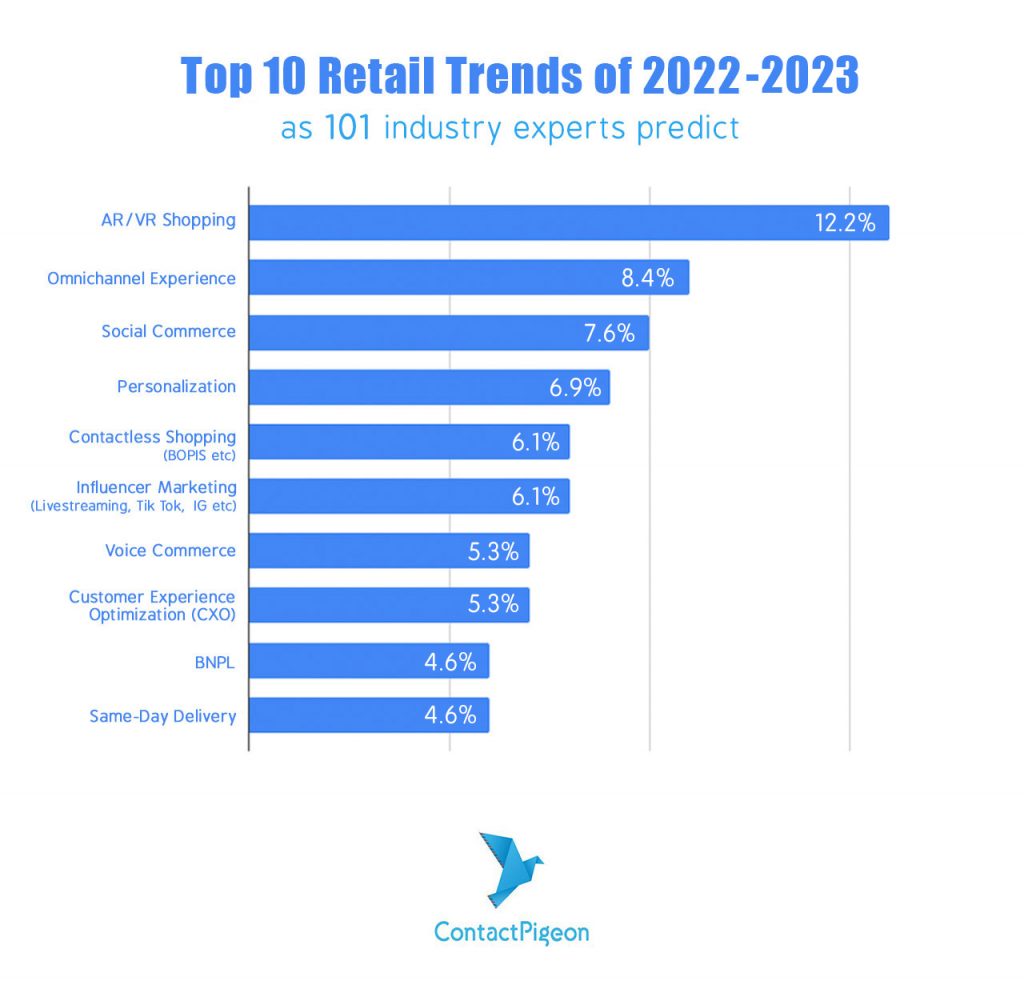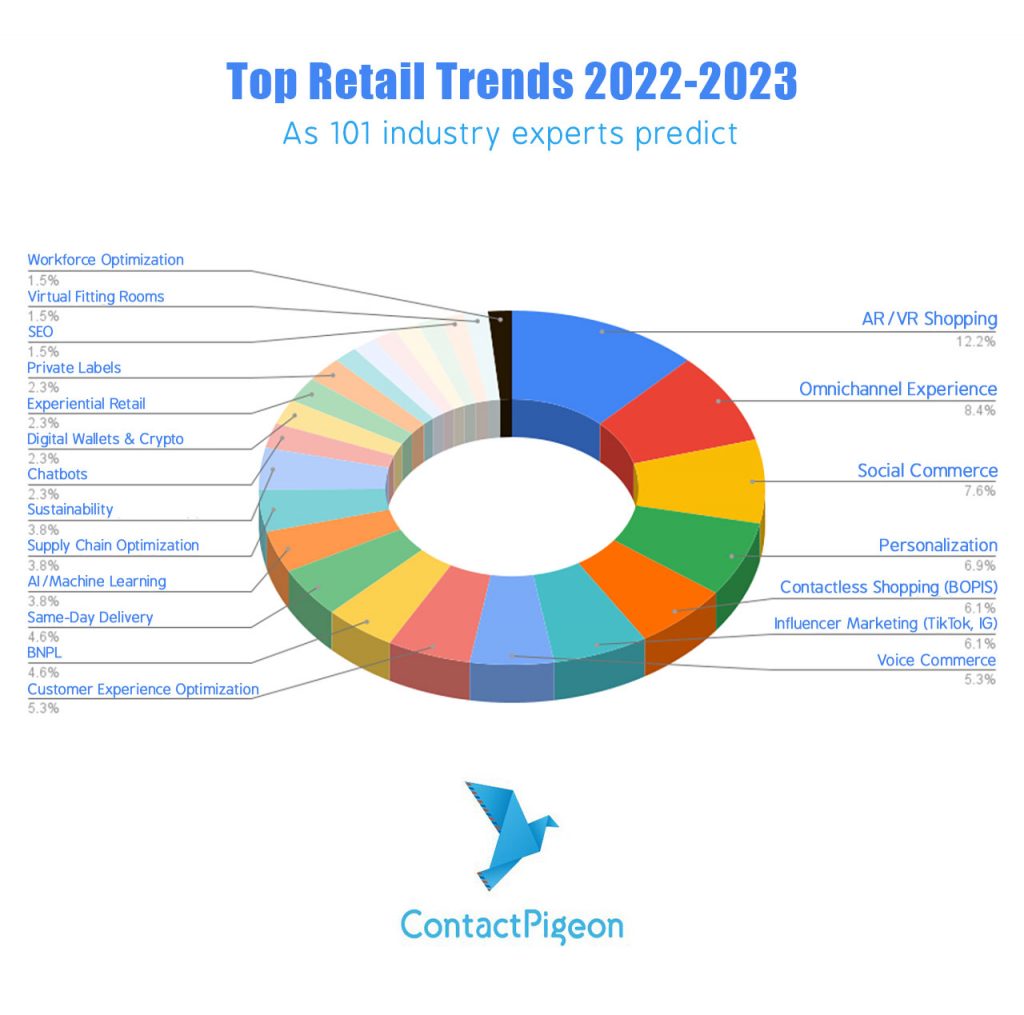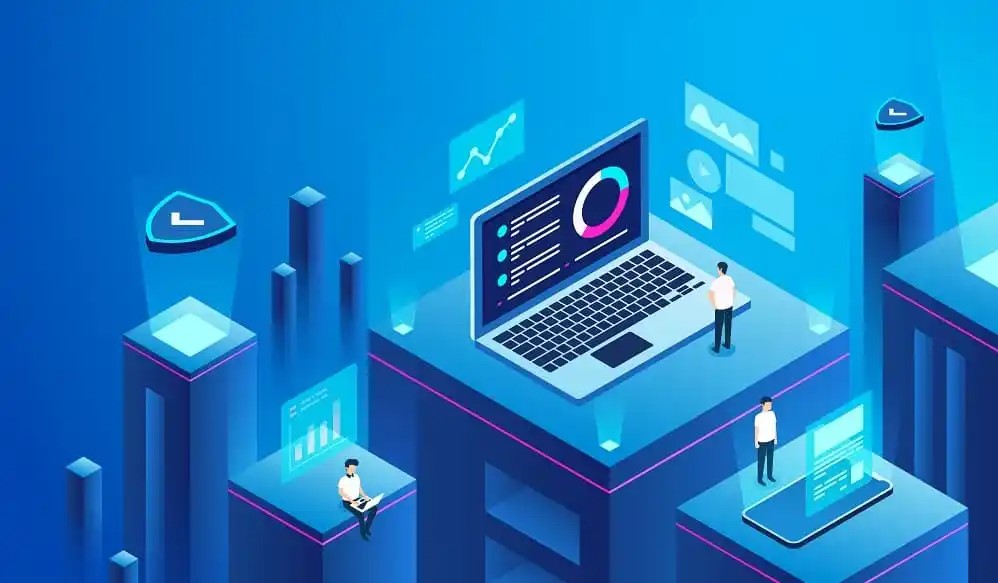Since 2020, the retail industry has been challenged by numerous threats and challenges. At first, it was the pandemic that shook the world, pushing the eCommerce adoption rate to +30% over the 2019 levels and fiercely switching the purchase behavior of consumers across the world. In 2022 and as the world tried to normalize its pace, the Ukrainian War, the energy crisis, and inflation shook the world, with 52% of the consumers claiming that the rising costs affect their ability to purchase goods, according to EY. The retail industry has been adapting to a new reality so we expect to see cutting-edge retail trends.
“Within the last three years, retailers had to adapt to the most volatile circumstances of the last 30 years, dealing with pandemics, war, inflation, and energy crisis.”
Thus, with the market in decline and the operational costs constantly rising, it is of significant importance for retailers to remain ahead of the competition.
At ContactPigeon we decided to interview 101 retail industry experts and professionals to share their insights and predictions, in order to identify the top retail trends for 2022 and 2023.
Here is a table of contents to help you quickly navigate through this small-scale retail study.
Table of Contents
- Key insights: The top Retail Trends of 2022-2023
- Retail Expert #1: Brian Dean, Co-Founder, Exploding Topics
- Retail Expert #2: Sasha Quail, Business Development Manager, Claims UK
- Retail Expert #3: Milena Farber, Social Media Marketing Manager, Namogoo
- Retail Expert #4: Olga Dogadkina, Founder, Emperia
- Retail Expert #5: George Mirotsos, CEO, ContactPigeon
- Retail Expert #6: Najla Kayyem, Senior Vice President of Marketing, Pacific Retail Capital Partners
- Retail Expert #7: Dr. Saksham Sharda, Chief Information Officer, Outgrow
- Retail Expert #8: Jeff Mains, CEO, Champion Leadership Group LLC
- Retail Expert #9: Brian Kelso, CEO, BSK DATA & ELECTRICAL PTY LTD
- Retail Expert #10: Jake Munday, CEO, Custom Neon
- Retail Expert #11: Andrei Vatca, Business Development, Flipsnack
- Retail Expert #12: Liz Giorgi, CEO, Soona
- Retail Experts #13 & #14: Lee Whitaker & Mike Johnson, Senior Managers, The Parker Avery Group
- Retail Expert #15: Alexa Allamano, Owner, Foamy Wader
- Retail Expert #16: Adam Ng, CEO & Founder, Trusted Malaysia
- Retail Expert #17: Olga Voronkova, Marketing director, KeyUA
- Retail Expert #18: Karl Reynolds, Marketing Project Manager, PriceShape
- Retail Expert #19: Chelsea Cohen, Co-founder, SoStocked
- Retail Expert #20: Daniel Foley, Founder, Daniel Foley SEO
- Retail Expert #21: Burak Ozdemir, Founder, Alarm Journal
- Retail Expert #22: Daniela Sawyer, Founder, FindPeopleFast.net
- Marketing Expert #23: Retail Expert #23: David Reid, Sales Director, Vem Tools
- Retail Expert #24: Simonas Steponaitis, Marketing Manager, Do Fasting
- Retail Expert #25: Amy Wampler, CEO, Spartan Mechanical
- Retail Expert #26: Michael Baggs, Director of Strategy, The Social Element
- Retail Expert #27: Katie-Jay Simmons, Staff Writer/eCommerce Specialist, Fit Small Business
- Retail Expert #28: Leslie Gilmour, Owner, ServisBOT
- Retail Expert #29: John Williams, Lead developer and Director, TheSnugCo
- Retail Expert #30: Jeff Meeks, VP of Sales and Marketing, EnergyFit
- Retail Expert #31: Chris Nddie, Co-Owner, ClothingRIC
- Retail Expert #32: Jacob Olins, VP of Marketplace and Strategic Partnerships, Epos Nowg
- Retail Expert #33: Olivia Tan, Co-founder, CocoFax
- Retail Expert #34: Alex Williams, CFO, FindThisBest LLC
- Retail Expert #35: Jan-Willem Bats, Co-Founder & Developer, ContentBASE
- Retail Expert #36: Lauren Cook-McKay, Director of Marketing & Content, Divorce Answers
- Retail Expert #37: Nicholas Rosenfeld Director, Making a Will
- Retail Expert #38: VipinPorwal, Founder, Smarty
- Retail Expert #39: Brigitte Hodge, Staff Writer, Fit Small Business
- Retail Expert #40: Dan Close, Founder & CEO, We Buy Houses in Kentucky
- Retail Expert #41: Jonathan Roque, Digital Marketing and Content Strategist, Zapiet
- Retail Expert #42: Jake Rheude, Vice President of Marketing, Red Stag Fulfillment
- Retail Expert #43: David Wurst, Owner and CEO, Webcitz
- Retail Expert #44: Steve Pogson, Founder & E-commerce Strategy Lead, FirstPier
- Retail Expert #45: Vladimir Ilinov, VP Marketing, Retalon
- Retail Expert #46: Laura Jimenez, Owner, Ishine365
- Retail Expert #47: Farhan Advani, Director Marketing, Buy Here Pay Here
- Retail Expert #49: Retail Expert #48: Kathryn Smithson, CMO, PathSocial
- Retail Expert #49: Paige Arnof-Fenn, Founder & CEO, Mavens & Moguls
- Retail Expert #50: Retail Expert #50: Sarah Jameson, Marketing Director, Green Building Elements
- Retail Expert #51: Matt Weidle, Business Development Manager, Buyerβs Guide
- Retail Expert #52: Sep Niakan, Managing Broker, Condoblackbook
- Retail Expert #53: Hassan Usmani, Tech Expert, YEELIGHT
- Retail Expert #54: John Lawless, Content & SEO Manager, Limitless Digital Group
- Retail Expert #55: Andrew Priobrazhenskyi here, CEO, DiscountReactor
- Retail Expert #56: Melanie Bedwell, eCommerce Manager, OLIPOP
- Retail Expert #57: Rusty Bishop, CMO, Bigtincan
- Retail Expert #58: Oskar Nowik, Head of SEO, Bonsai
- Retail Expert #59: Nate Tsang, Founder & CEO, WallStreetZen
- Retail Expert #60: Mike Ziarko, Founder & CEO, No More Chores
- Retail Expert #61: Vincent Choi, CEO, Pomelo Pay
- Retail Expert #62: James Diel, Founder & CEO, Textel
- Retail Expert #63: Nick Drewe, Founder & CEO, Wethrift
- Retail Expert #64: Bob Buffone, Co-founder & CTO, YOTTAA
- Retail Expert #65: Evan McCarthy, Founder, Sporting Smiles
- Retail Expert #66: Jean Gregoire, Founder and CEO, Lovebox
- Retail Expert #67: Darren Litt, Co-Founder, Hiya Health
- Retail Expert #68: Basheer Alebdy, Founder, DaBash Deals
- Retail Expert #69: Maegan Griffin, Founder, CEO, and Nurse Practitioner, Skin Pharm
- Retail Expert #70: Elice Max, Co-Owner and Marketing Director, EMUCoupon
- Retail Expert #71: James Parsons, CEO, Content Powered
- Retail Expert #72: Dino Ha, Manager, Founder and CEO, MBX
- Retail Expert #73: Sally Stevens, Co-founder & Marketing Manager, FastPeopleSearch.io
- Retail Expert #74: Andrew Troya, Marketer, Fenix Commerce
- Retail Expert #75: Hoi Yi Leung, Content Writer, SleekFlow
- Retail Expert #76: Jason White, CEO, All About Gardening
- Retail Expert #77: Austin Dowse, CEO, Aimvein
- Retail Expert #78: Nikita Chen, CEO, LegitGrails
- Retail Expert #79: Jake Smith, Managing director, Absolute Reg
- Retail Expert #80: David Farkas, Founder & CEO, The Upper Ranks
- Retail Expert #81: Eden Cheng, Co-Founder, PeopleFinderFree
- Retail Expert #82: Mark Valderrama, CEO & Founder, Aquarium Store Depot
- Retail Expert #83: Jesse Forrest, Founder, Copywriting Crew
- Retail Expert #84: Patrick Crane, CEO, Love Sew
- Retail Expert #85: Robert Johansson, CEO & Tech Expert, imgkits
- Retail Expert #86: Shiv Gupta, Marketing Director, Incrementors Lead Generation
- Retail Expert #87: Yuvi Alpert, Founder, Creative Director & CEO, NoΓ©mie
- Retail Expert #88: Becky Brown, CEO & Co-Founder, ShoppingKim
- Retail Expert #89: Kathryn McDavid, CEO, Editorβs Pick
- Retail Expert #90: Leanna Serras, Chief Customer Officer, FragranceX
- Retail Expert #91: David Bitton, Co-Founder & CMO, DoorLoop
- Retail Expert #92: Susan Smith, Marketing Manager, Velden Engineering
- Retail Expert #93: James Khoury, CEO, Zendbox
- Retail Expert #94: Andy LaPointe, Owner & Director of Marketing, Traverse Bay Farms
- Retail Expert #95: Kyle MacDonald, Director of Operations, Force by Mojio
- Retail Expert #96: Sara Shah, Co-Founder & Co-CEO, Journ
- Retail Expert #97: Chris Muller, Director of Audience Growth, DoughRoller
- Retail Expert #98: Gerrid Smith, Chief Marketing Officer, Joy Organics
- Retail Expert #99: Angelina Mahany, CEO & Founder, Angieβs Showroom
- Retail Expert #100: Rohit Bimbra, Founder & CEO, HomeHealthcareShoppe.com
- Retail Expert #101: Mark Daoust, CEO, Quiet Light
- Conclusion
Key insights: The top Retail Trends of 2022-2023

The Top 10 Retail Trends of 2022-2023, as predicted by our experts, are:
- Retail Trend #1: AR/VR Shopping
- Retail Trend #2: Omnichannel Experience
- Retail Trend #3: Social Commerce
- Retail Trend #4: Personalization
- Retail Trend #5: Contactless Shopping
- Retail Trend #6: Influencer Marketing (Livestreaming, TikTok/IG Marketing)
- Retail Trend #7: Voice Commerce
- Retail Trend #8: Customer Experience Optimization (CXO)
- Retail Trend #9: BNPL (Buy Now Pay Later)
- Retail Trend #10: Same-Day Delivery
Other emerging retail trends of the industry:
- Private Labels
- Blockchain/Cryptocurrency/Digital Wallets
- Virtual Fitting Rooms
- Chatbots
- Supply Chain Optimization
- Sustainability

Other key observations & useful insights:
- 3 out of 5 top retail trends of 2023 were also included in 2021’s top retail trends list.
- Omnichannel is steadily for the third year in a row among the top three retail trends.
- BNPL recorded a significant YoY rise, despite not getting a single vote in 2021. This highlights the industry’s potential, adoption rate, and maturity against this retail trend within the last 12 months.
- Total retail trends spotted: 172
- Retail trends per expert: 1.71
- Unique retail trends spotted: 65
- Total retail professionals involved: 101
- Background of the experts interviewed: retailers, agencies, B2B retail SaaS
Retail Expert #1: Brian Dean, Co-Founder, Exploding Topics

Create an Omnichannel Experience
The omnichannel approach is automation’s soul mate. They require and complement one another, resulting in a superior e-commerce experience for both buyers and merchants. To sell on marketplaces, stick to the tried-and-true method of investigating buying retail trends as well as consumer needs, concerns, and priorities, which are changing faster than ever in 2022.
You can make all of your channels – including marketplaces – into a single purchasing experience by offering consistent information across all of your sales channels, high-quality visual materials, and a consistent brand image. It’s also crucial to give them a method to transfer across channels: from online ads to the marketplace, from social media to your virtual store, and so on. We gained up to 166% more attention from the user with an omnichannel approach than with a single-channel sales approach.
Retail Expert #2: Sasha Quail, Business Development Manager, Claims UK

Sasha Quail
Business Development Manager, Claims UK
“Social commerce has offered hyper-personalized end-to-end buying experiences based on a wealth of real-time customer data.”
Social Business
Native buying experiences on a social media site are referred to as social commerce. It allows customers to purchase online in a more seamless manner. Users may make purchases directly from the social networking app or site, rather than going to a third-party website. The barriers between app users and retail consumers blurred as media platforms became the one-stop shop for real-time engagement, interesting content, and purchasing inspiration. As a result, social commerce has offered hyper-personalized end-to-end buying experiences based on a wealth of real-time customer data. The customer journey has flipped on its head. 90% of product research and decision-making is now accomplished before customers enter a store.
The popularity of social commerce is on the upswing. We’ll see cooperation between Shopify and TikTok, as well as Facebook businesses, in 2020. By the close of 2021, sales of social commerce in the United States are predicted to have increased by 35%, surpassing $36 billion.
Retail Expert #3: Milena Farber, Social Media Marketing Manager, Namogoo

Milena Farber
Social Media Marketing Manager, Namogoo
“Shoppers expect personalization. Leveraging this along with multichannel selling creates opportunities to connect with customers wherever they are in their journeys”
It’s the end of the year and I’d like to share with you where we see eCommerce heading in 2022!
- Multi-Channel Personalization: There’s no way around it- shoppers expect personalization. Leveraging this along with multichannel selling creates opportunities to connect with customers wherever they are in their journeys, increasing conversion rates and improving customer loyalty.
- Increased use of AI: Investing in Artificial Intelligence and Machine Learning to scale workflows and processes. By next year, online sellers are expected to spend more than $7 billion on AI alone, giving retailers the power to deliver data-driven customer experiences.
- Rise in Mobile Shopping: Shoppers use mobile devices at all stages of their digital journeys, from product investigation to purchase. In fact, almost 73% of eCommerce purchases happen on a mobile device. Be sure to invest in and optimize your mobile sites.
- Investing in Intent and First-Party Data: Due to recent iOS updates and increased global regulations around the use of 3rd party data and cookies, eCommerce marketers will be looking to intent and first-party data collection to overcome this obstacle and deliver enhanced and personalized customer experiences.
Retail Expert #4: Olga Dogadkina, Founder, Emperia

Olga Dogadkina
Founder, Emperia
“Introducing productivity tools and real-life applications to virtual reality could dramatically improve the rate of adoption creating a more connected user experience.”
People are realising that this is the future and that virtual reality can be integrated into every step of the cycle; design, production, wholesale, sales. It’s accessible and sustainable in that sense. But also, it’s about creating a connection with something that people might not be able to physically reach.
This e-commerce shift was already imminent before, but the pandemic has catalysed it. Brands at the premium end like Burberry (who we’ve worked with) and even high street retailers like Zara are experimenting.
Beyond the improvements to hardware, i.e. better lenses, higher screen resolution etc, the utilitarian value of VR software is rather limited. Up until now, we’ve seen VR being mainly the domain of gamers; introducing productivity tools and real-life applications (such as shopping, learning, medical) to virtual reality could dramatically improve the rate of adoption creating a more connected user experience.
Retail Expert #5: George Mirotsos, CEO, ContactPigeon

George Mirotsos
Co-founder, ContactPigeon
“Monitoring visitor behavior across all digital and physical channels is a must in 2023 and will aid retailers in understanding how their customers’ habits shift between different touchpoints.”
Surely 2022 brought forth a lot of new and exciting retail trends, but it also expanded the possibilities of some already existing ones. Now that eCommerce is facing a steady decline, retailers have to re-evaluate their strategies and invest in technological advancements that will produce maximum results, while offering the best possible customer experience.
The retail trends that have emerged from this digital renewal include a combination of hyper-automation with the capabilities of omnichannel engagement. Monitoring visitor behavior across all digital and physical channels is a must in 2023 and will aid retailers in understanding how their customers’ habits shift between different touchpoints. The next step for a complete customer-centric approach is the hyper-automation of personalized and targeted marketing campaigns with the use of data, AI, and machine learning. Last but not least, chatbots are a very valuable tool that can act as the perfect mediator for a seamless customer journey and deliver top-notch customer satisfaction.
Retail Expert #6: Najla Kayyem, Senior Vice President of Marketing, Pacific Retail Capital Partners

Najla Kayyem
Vice President of Marketing, Pacific Retail Capital Partners
“Omnichannel sales and BOPIS (buy online pickup in-store) will continue to be an essential key to success”
The future of shopping centers and in-person shopping: instore /IRL shopping is still an experience many people are seeking out currently and we are seeing positive retail trends for retailers throughout our US shopping centers. However, people are looking for a different experience as they journey away from their homes. Consumers will experience shopping centers with more open green space and communal areas with year-round outdoor seating. Mixed-use of the space with pop-up shops to bring local and small businesses the opportunity to sell directly to consumers must be also included in the retail trends of 2023. Pet centers, entertainment areas, senior services, and wellness continue to thrive.
Omnichannel sales and BOPIS (buy online pickup in-store) will continue to be an essential key to success and centers will continue to expand areas to assist in creating ease of experience for their customers. Livestream shopping /virtual reality. With the rise of influencer marketing and social media marketing, consumers have adapted to new ways to experience products and make purchases. Customers have become channel agnostics and want to shop when and how is most convenient for them.
Retrofit, Reposition and Redevelop are the new reduce, reuse, and recycle. Brands must rethink how brick-and-mortar spaces are being used to create elevated and efficient experiences for their customers from try-ons to checkout. Shopping centers need to smartly use their space to create a safe and engaging customer experience.
Retail Expert #7: Dr. Saksham Sharda, Chief Information Officer, Outgrow

Saksham Sharda
CIO, Outgrow
“Interactive content is going to be the top emerging retail trend in 2023.”
Interactive content is going to be the top emerging retail trend in 2023 . The use of recommendation quizzes that help beat your customers’ choice paralysis and decision fatigue is going to be key. For instance recommendations quizzes like “Which Sunglasses Suit Your Face the Best” or “Which Makeup Set Should You Buy” that ask relevant questions regarding your face shape, hair colour, eye colour, etc., and then provide products that are personalized for you are going to be the next big thing. Amazon, L’Oreal, Sephora, and various other brands already use such quizzes on a large scale.
Retail Expert #8: Jeff Mains, CEO, Champion Leadership Group LLC

Jeff Mains
CEO, Champion Leadership Group LLC
“To keep up with the rapid speed of digital innovation, 2023 users expect retail businesses to provide fresh customer experiences.”
Even though COVID-19 affected 2020-2021, buying habits did not alter. All businesses and industries that had lagged in the emergence of online shopping portals were compelled to hasten their digital transformation due to this. To keep up with the rapid speed of digital innovation, 2023 users expect retail businesses to provide fresh customer experiences.
The ability to run an eCommerce company is no longer a luxury; instead, it is an absolute must for every shop looking to generate revenue in the post-pandemic years. Global eCommerce retail sales surged by more than 25% in this pandemic year alone, highlighting the necessity of a retail eCommerce enterprise. That being said, here’s one of the top retail trends in 2023:
A shopping experience that is enhanced by augmented reality.
Incorporating augmented reality into your eCommerce shop may provide your company a competitive advantage over your competitors. Millions of buyers have utilized virtual reality technology to make online purchases. Most of them would make more purchases if eCommerce offered a virtual test to check a product.
With this innovation, customers may get a better visual representation of the goods they wish to purchase, allowing them to have a more enjoyable in-store experience. The retail business is an example of a sector that has benefited from this advancement in technological capability. Zara has begun to deploy it via reality models and a new eCommerce platform that displays life-size models dressed in the brand’s most recent collections. Because it is possible to purchase garments via the app, businesses may create online sales due to this.
Retail Expert #9: Brian Kelso, CEO, BSK DATA & ELECTRICAL PTY LTD

Brian Kelso
CEO, BSK DATA & ELECTRICAL PTY LTD
“There are numerous ways a customer can draw in with a brand, and every road gives a chance to convey customized interchanges.”
Develop As Platforms To Create One-Stop Shopping For Customers
Retailers today are venturing into local areas, content, and a more extensive item determination. As indicated by the Publicis Sapient examination, the future champs of retail will be those that form an associated biological system of related administrations that clients can draw in through one consistent experience. Customers need to connect with retail marks that offer accommodation. Retailers that make esteem-improving, separated biological systems can give a scope of things explicit to their classification, which can turn into a helpful “all-in-one resource” for buyers.
Reconsider Store Experiences By Integrating Best of Online and Offline
In the course of the most recent year and a half, retailers have confronted lockdowns and limitations, bringing about a flood in internet business that has changed purchaser assumptions and the job of actual stores. While the shift to web-based shopping gives no indications of easing back, Publicis Sapient examination shows 52% of buyers in the US said they intend to make most of their retail chain buys in stores this Christmas season. In 15 years, stores will in any case be pertinent and will be the best spot for shoppers to encounter a brand.
Adapt Data To Increase Brand Engagement and Sales
There are numerous ways a customer can draw in with a brand, and every road gives a chance to convey customized interchanges. As per Publicis Sapient exploration, 37% of customers who purchase online would like customized offers dependent on spending inclinations, while 31% need customized content or counsel to help them shop. Retailers should separate information storehouses inside their associations to acquire a more clear view and better comprehension of their clients’ inclinations.
Retail Expert #10: Jake Munday, CEO, Custom Neon

Jake Munday
CEO, Custom Neon
“The rapid expansion of online shopping has forced many retailers to reconsider the importance of a physical storefront, with many opting to switch to an online-only model”
2022 is sure to be another major year of change for the retail industry, particularly in the e-Commerce space. Businesses are continuing to learn from the lessons of the COVID-19 pandemic, a crisis that highlighted the fragility of supply chains and the importance of a strong online presence.
One of the key emerging retail trends that I expect to see continue to flourish in 2023 is customer personalization. Consumers are eager to make products their own, with landmark initiatives such as the Nike ‘For You’ tool and Xbox design lab paving the way for personalization in the retail industry. Providing consumers with new and exciting ways to customize their products encourages repeat purchases and social media engagement, as customers share their unique products via channels such as Instagram and Tik-Tok. As this retail trend continues to gain traction in 2022, I expect to see barriers to entry be reduced, allowing SMBs to offer personalized products without needing the deep pockets associated with companies like Nike and Microsoft.
One other of the most important retail trends that I see becoming prevalent over the course of 2023 is the adoption of showroom-styled physical destinations for businesses of all shapes and sizes. The rapid expansion of online shopping has forced many retailers to reconsider the importance of a physical storefront, with many opting to switch to an online-only model. Showroom-style storefronts have been growing in popularity, something that I expect to continue in 2023 and businesses look to uniquely present their offerings without necessarily expecting the final purchase to be made in-store. These new types of retail destinations allow businesses to experiment and create memorable in-store experiences that set their offerings apart from the wide range of competitors found online, many of which are cheaper and more varied.
Retail Expert #11: Andrei Vatca, Business Development, Flipsnack

Andrei Vatca
Business Development, Flipsnack
“Most dynamic retailers developed multiple communication strategies to maximize the “outcome of the relationship between the two counterparts”
A shift towards online shopping
According to a study by Retail Customer Experience, shopping in person was preferred, with 60% of adults stating that they shopped mainly in person pre-pandemic. However, the numbers have fallen to a bit over 35% now. In addition, 42% of the survey participants anticipate that they will be shopping in person as online in a year.
Omnichannel marketing
In exchange for their loyalty and spending, buyers have set high standards and expectations, challenging retail brands to be creative. As a result, many retailers are now spreading their marketing campaigns across multiple channels rather than focusing on one or two. Additionally, most dynamic retailers developed multiple communication strategies to maximize the “outcome of the relationship between the two counterparts”, so omnichannel marketing is among the top retail trends and it is here to stay.
Efficient corporate communication and technology adoption
This technological world we’re living in has left a mark on the retail & wholesale industry. Since more people prefer online shopping, retailers must facilitate this buying process. That’s why they are pairing with digital publishing platforms such as Flipsnack to create product catalogs rich in interactive elements, web compatible, and loved by potential buyers.
Something ‘nice to have’ has now become a ‘must have’
Before the pandemic, a PDF to HTML5 solution was only “nice to have”. Now, the situation is different. Features such as videos, hyperlinks, product tags, iframe popups, Shopify integrated carts, and even automation or integration with content management systems are some “must-have” elements Flipsnack provides for retailers.
Doing business development for Flipsnack allowed me to work with retailers and global trendsetters such as Auchan. They wanted to embed interactive documents on different countries’ websites. Flipsnack’s API facilitated integrations with each country’s content management system. Moreover, they could also add interactive elements to their documents, collaborate on different projects, and automate the document production process.
Retail Expert #12: Liz Giorgi, CEO, Soona

Liz Giorgi
CEO, Soona
“Now more than ever, consumers (particularly younger generations) are purchasing products on ecommerce sites and social media platforms rather than in shopping mall window displays.”
E-commerce has been on the rise for several years; however, the COVID-19 pandemic has drastically shifted consumer buying habits from brick-and-mortar to online shopping. Now more than ever, consumers (particularly younger generations) are purchasing products on eCommerce sites and social media platforms rather than in shopping mall window displays. In fact, 72% of all e-commerce is expected to be m-commerce (mobile e-commerce) by the end of 2022.
Recently, small businesses have been capitalizing on this online shift by ensuring consumers are exposed and able to purchase their products on mobile devices. Small businesses that fail to adjust their marketing strategies following this here-to-stay retail trend in mobile eCommerce can miss out on a significant amount of growth. This year proved an increase in small businesses having:
1. online storefronts that are compatible with all smart devices
2. products on marketplaces like Shopify, Amazon, and Instagram
3. products available through in-app purchasing on platforms like Instagram and Facebook
4. high-quality product imagery for sites and digital ads that mimic the traditional in-store shopping experience.
All in all, businesses are realizing this: if their products aren’t available on mobile, they’re missing out, so a mobile-first approach is on my top retail trends list for 2023.
Retail Experts #13 & #14: Lee Whitaker & Mike Johnson, Senior Managers, The Parker Avery Group


Lee Whitaker
Senior Manager, The Parker Avery Group
” Retailers are exploring ways to quickly adopt advanced analytics with expanded data sets into their business processes to drive better decisions and enable capabilities throughout their retail channels.”
Mike Johnson
Senior Manager, The Parker Avery Group
“A key driver of optimized omnichannel and supply chain capabilities is the infusion of advanced data science”
As retailers continue to navigate the disruptive factors that have forever impacted the way they do business, ongoing and emerging challenges continue to drive transformational change. Omnichannel retailing, driven by consumer behavior shifts that demand more options for shopping and fulfillment has altered the way that retailers manage their largest investment: inventory. This challenge is complicated further by uncertain availability and timing related to the global supply chain issues that are far from over.
A key driver of optimized omnichannel and supply chain capabilities is the infusion of advanced data science—skillsets once delegated to the IT or finance departments. Retailers are exploring ways to quickly adopt advanced analytics with expanded data sets into their business processes to drive better decisions and enable capabilities throughout their retail channels.
Moving into 2023, we see three key retail trends emerging as capabilities retailers can use to improve their ability to meet their customer’s needs.
Data science and advanced analytics become mainstream in the business.
Data science comes out of the “shadows” of IT and/or finance and is more fully embraced as a key leverageable skillset that all retailers turn into a true strategic capability.
Retailers infuse data analytics into business processes such as merchandising, pricing, promotions, and operations to influence business decisions.
Demand forecasting accuracy is enhanced by improving and expanding internal and external data inputs. Better forecast accuracy mitigates the volatile and unreliable historical data (LY, LLY) that has defined the last several pandemic years.
Further, retailers will integrate a single, improved demand signal to downstream execution systems and enable much tighter collaboration throughout the enterprise and supplier networks.
Results as a service (RAAS) analytics delivery models gain popularity for retailers who have yet to mature in this space.
Sustainable supply chain resiliency moves to a top priority.
The pandemic and its lingering aftereffects further prove that supply chain excellence should be a top priority for all retailers—and it must be sustainable.
End-to-end inventory visibility from the factory source to retail store shelves moves to the forefront of supply chain initiatives as retailers blinded by pandemic delays, etc. strive to get out in front of the inventory risks that affect customer satisfaction.
Strategic sourcing shifts to strengthening the supply channel by moving away from traditional single-threaded relationships. No longer driving volume through a few suppliers, new supply chain models will expand their supplier network to minimize risk when the supply base becomes disrupted.
Allocation and replenishment capabilities will expand with supply chain influences, as opposed to the traditional reactive task-based view related to the typical merchandising cycle.
Further, the supply chain will influence fulfillment processes to provide better input in the order and delivery cycles. Sustainability must be included in the top retail trends of 2023.
Omnichannel quickly matures (this time correctly)—and with more competitors.
Retailers finally get omnichannel capabilities right—or at least much closer. Many will correct the issues of pandemic-initiated band-aid approaches with improved master data, infrastructure, processes, and software to create a forward flexible omnichannel experience for their customers.
Retailers strengthen capabilities around real-time inventory and visibility. Better inventory accuracy leads to an improved ability to meet customer demand, especially related to exposing all inventory, including stores, to fulfill omnichannel orders.
More direct-to-consumer (DTC) retailers will expand their footprint into traditional brick-and-mortar retail locations. They take advantage of surplus retail space to begin reaching a new set of customers and expand their physical presence.
Retail Expert #15: Alexa Allamano, Owner, Foamy Wader

Alexa Allamano
Owner, Foamy Wader
“Retailers can capitalize on impulse browsing by merchandising store windows with a system of scannable QR codes.”
One of the most emerging retail trends for 2023 is the use of QR codes for literal window shopping. Retailers can capitalize on impulse browsing by merchandising store windows with a system of scannable QR codes. Doing so creates an alfresco shopping experience that meets customers where they’re at, even outside normal business hours. Shoppers use their smartphone camera to scan the QR code next to an item in the window and be led to order that exact item online, bypassing the friction of poor searchability (the top pain point in online shopping). This approach to “shopping online IRL” facilitates hassle-free mobile checkout and is a perfect companion to the option of buy online pickup in store (BOPIS).
Retail Expert #16: Adam Ng, CEO & Founder, Trusted Malaysia

Adam Ng
CEO & Founder, Trusted Malaysia
“In the wake of the pandemic, and in a retail environment that has experienced profound upheavals, retailers are emerging stronger than ever by embracing new opportunities.”
In 2020 and 2021, we saw massive growth in social commerce, influencer marketing, and even advancements in augmented reality shopping experiences. As a result of the pandemic, eCommerce grocery platforms are now the new norm for millions of shoppers nationwide. In the wake of the pandemic, and in a retail environment that has experienced profound upheavals, retailers are emerging stronger than ever by embracing new opportunities. Here are some of the most important emerging retail trends to watch for.
Social Commerce
The surge in online shopping is here to stay, especially given the hurdles presented by the COVID-19 pandemic and the closure of brick-and-mortar stores. Social commerce — native shopping experiences on a social media platform — offers shoppers an even more seamless way to shop online. Instead of clicking through to a third-party website, users can make purchases right from the social media app or site, social commerce is on the rise. Shops are custom storefronts for businesses on Instagram and Facebook. Sellers can create collections of featured products, as well as modify the look of their Shop with banners, images, colors, and buttons. The same Shop can be accessed from both Facebook and Instagram, so once it’s set up, sellers have the potential to reach a wide global audience on two platforms.
A New Approach to Influencer Marketing
Influencer marketing used to be all about selfies, carefully-constructed captions, and heavily-edited product shots. But in 2021, we’ve seen a major shift in the way brands and influencers work together. Influencer content has slowly transitioned to a raw, real aesthetic, and this change will continue into 2023 retail industry trends. Audiences put trust in brands that showcase authentic voices, and today’s savvy users can spot an overly-produced ad from a mile away. Brands that don’t prioritize authenticity in their influencer partnerships can wave goodbye to high engagement and ROI next year. It’s time to focus on unique influencer content that prioritizes education, entertainment, and the viewer experience.
Technology helps staff deliver a competitive advantage
Experiential retail also highlights the ways that staff are a key competitive advantage. Whether customers are shopping in person or online, interactions with skilled and knowledgeable staff are essential. With technology, retail staff can access optimized data to deliver more personalized experiences. Technology also gives staff tools to support customers in their journeys across multiple channels.
Even More AR-Powered Shopping Experiences
The innovative retail trends of Augmented reality (AR), machine learning, and artificial intelligence (AI) are here to stay. And while AR in retail isn’t new (Facebook made some big AR moves in 2018), it’s gone from a nice-to-have to an essential part of retailers’ eCommerce offerings. As so many shoppers continue to rely on online shopping during the pandemic, retailers leverage AR technology to bridge the gap between the digital and the physical. In fact, IBM’s 2020 U.S. Retail Index reports that COVID-19 has accelerated the shift to digital shopping by roughly five years.
Same-Day (or Faster) Delivery
It wouldn’t be a retail trends roundup without mentioning fulfillment, especially when sales from same-day shipping pioneer Amazon are higher than ever. It seems like customer expectations for shipping times are only getting faster. First came 2-day via the rise of Amazon Prime, then next-day, then same-day. And big-box stores are following in Amazon’s footsteps, with Target growing its Shipt service and Walmart expanding its two-hour express delivery options. But in the age of instant gratification, shoppers want their orders ASAP. And same-day, store-fulfilled orders are seeing more traction from customers and brands alike.
Increase in Smart Speaker Shopping
Amazon Echo and Google Home smart speakers have become key tools for many online shoppers, especially as we all spend more time at home during the pandemic. Around 20% of smart speaker owners use them for shopping activities, such as ordering products, conducting product research, or tracking deliveries. This figure is expected to jump to 52% within the next four years. As we move into 2022, we can expect to see more consumers online shopping without ever having to look at a screen, especially on Amazon. But even brands that aren’t on Amazon can leverage smart speakers and voice search technology. Here’s why: When a voice assistant provides an answer, it also allows users to open the website where the answer was found. For brands that prioritize voice-optimized SEO, this could mean a boost in traffic.
Increased Use of Chatbots
As Covid-19 has limited in-person experiences, retailers have had to severely reduce face-to-face customer support and lean towards more innovative retail trends. To meet customers where they are, more and more companies have embraced chatbots and personal assistants. The retail industry was already using this technology prior to the pandemic, along with the banking and healthcare sectors. Though there are certainly benefits to in-person experiences, chatbots offer companies and users alike some big advantages, like shorter wait times and 24/7 availability. It’s also important to note that chatbots can go above and beyond recreating in-person experiences — they can create fun, new experiences unique to the digital space.
Retail Expert #17: Olga Voronkova, Marketing director, KeyUA

Olga Voronkova
Marketing director, KeyUA
“In today’s world retailers are bound to create new and innovative ideas to grasp the attention of customers worldwide.”
Retail with Artificial Intelligence
Retails embracing digital tools has helped transform their businesses by providing increased accuracy and speed alongside efficiency as well. Through tools customers are eagerly expecting personalized products; Artificial Intelligence is gaining prominence.
Contactless Shopping
As all of us are well aware of how COVID has affected the world, non-contact methods throughout all platforms are highly recommended. Similarly, retail platforms have implemented contactless shopping to keep their sales up and their customers’ health too. Although sometimes there may be issues regarding sizes or colors not matching the picture, overall it is a safer bet rather than going in person with higher chances of risk.
Contactless payment options have also been implemented to keep the “no-contact” retail trends going. The use of credit or debit cards, PayPal, UPI, Gpay, and various other online payment methods have kept customers at a perfect distance while enjoying the thrill of shopping.
Retail stores have also upped their usage of technology by providing virtual try-on too in case clients are not satisfied with window shopping.
Experiential Retail
In today’s world retailers are bound to create new and innovative ideas to grasp the attention of customers worldwide. While doing so, some retailers have improvised by providing art galleries or cafes beside their stores. This way, they may grasp the attention of potential collaborators who can offer mutual benefits. Through collaborations, retailers gain more customers and increase revenue without much effort. Alongside AI, using VR or even other digital tools will help keep customers interacting and build loyalty.
Retail Expert #18: Karl Reynolds, Marketing Project Manager, PriceShape

Karl Reynolds
Marketing Project Manager, PriceShape
“More and more online retailers will look to adopt competitor monitoring and dynamic pricing software in 2022.”
The growth of eCommerce as a result of the COVID-19 pandemic has been well documented and, as it becomes apparent that the crisis is far from over, online retail businesses should continue to see increased demand throughout 2022.
This has been fuelled by traditional brick-and-mortar stores being forced to enter the online retail space as a result of numerous lockdowns, which has heavily impacted high street stores. With this increased growth of the industry comes increased competition, and nowhere will this be more apparent than the impact on prices.
With almost half of all product searches beginning on Google, consumers are easily able to find the best prices on offer through Google Shopping – which prioritizes lower prices when it comes to ranking.
This means that more and more online retailers will look to adopt competitor monitoring and dynamic pricing software in 2022. This will allow them to continuously monitor all of their competitors’ prices and dynamically alter their own prices, both up and down, to win more sales and maximize revenue.
Retail Expert #19: Chelsea Cohen, Co-founder, SoStocked

Chelsea Cohen
Co-founder, SoStocked
“This year, AI-based digital assistants took the spotlight because of their versatility in at-home and work-related tasks.”
Conversion rates will soar with more real-time purchases via Amazon Live. Interactive video marketing is one of the most rewarding strategies for e-Commerce and one of the most emerging retail trends.
Customers can purchase products directly through live-stream videos with sellers. It’s been an incredible sales booster for online retailers.
1-click checkouts will become the new norm. Time is one of the most expensive commodities in our society. Customers are continuously searching for quick ways to get tasks completed, which is why they love the convenience of 1-click orders.
Retailers should expect to see increased conversions through this integration. It’s no surprise that other major e-Commerce platforms, like eBay and Shopify, are adopting similar features to their services.
Alexa will be leading tech sales on the platform. This year, AI-based digital assistants took the spotlight because of their versatility in at-home and work-related tasks. They have a track record for making schedules less stressful, so consumers will likely favor devices with Alexa integrations.

Retail Expert #20: Daniel Foley, Founder, Daniel Foley SEO

Daniel Foley
Founder, Daniel Foley SEO
“Consumer behavior was trending towards eCommerce long before the epidemic, thus omnichannel isn’t a new concept.”
Omnichannel transforms every stage of the retail experience
Omni-channel retailing is a multichannel sales method that focuses on offering a consistent customer experience whether the customer is purchasing online, on a laptop, or in a physical store. 73 percent of clients utilize various channels during their purchasing experience, as per Harvard Business Review. Consumer behavior was trending towards eCommerce long before the epidemic, thus omnichannel isn’t a new concept. When businesses were compelled to limit in-person purchasing, online purchasing, and Click & collect became a backbone for customers in need of basic items, and omnichannel played a significant role in verticals like food and hardware for the first time.
Retail Expert #21: Burak Ozdemir, Founder, Alarm Journal

Burak Ozdemir
Founder, Alarm Journal
“Despite the rapid growth of online retail, creating a real physical connection with the customer will always be missed.”
Virtual fitting room. No matter how nice a garment or a shoe is doesn’t matter if it doesn’t fit. As a shopper, I always make sure to try first before buying something. And while the threat of the Covid-19 virus still won’t allow me to shop physically for my favorite shoes and shirts, online shopping is my best bet. But since I can’t try it and check if it fits, I often get the wrong sizes. But with the emergence of the virtual fitting room, “trying on” before buying something has again catered to me. And the best part, I didn’t have to physically visit a retail store to do it. Without having to leave at the comfort of my home, I was able to get the right apparel with the right fit for me. With it, I’m not only making the most out of my online shopping experience but is lowering the risk of exposure to Covid-19 as well.
Despite the rapid growth of online retail, creating a real physical connection with the customer will always be missed. And since everyone is still homebound, those who’ll provide a physical-like experience with a customer are sure to stand out. The virtual fitting room is the answer to it. Big retailers like Adidas and Macy’s are now taking advantage of it and are having positive results. It will be just a matter of time until it’ll dominate the online retail industry and will dictate retail’s success.
Retail Expert #22: Daniela Sawyer, Founder, FindPeopleFast.net

Daniela Sawyer
Founder, FindPeopleFast.net
“With the space crunch, current retailers have figured out some method for using every floor trace altogether.”
Current retailers are changing new improvements for propelling, retail tasks, and plans. Pivotal retailers are utilizing web media to converse with clients. With the space crunch, current retailers have figured out some method for using every floor trace altogether. Below are some retail trends in the industry for 2023.
Making retail sharper with automated reasoning: The motorized contrast has sped up sufficiency and accuracy across all business processes utilizing progressed information and discerning assessment gadgets. With clients anticipating a veritable level of personalization, AI-stimulated thought motors acquire conspicuous quality step by step. As shown by a market diagram, it is expected that 77% of retailers will utilize AI in their endeavors by 2022.
Contactless shopping experience: Broadened tidiness care and fears of pollution gather that touchless shopping experience across the client’s whole shopping experience are major to retail achievement. While virtual retail stores are now a standard across various business verticals, contactless shopping correspondingly melds different procedures:
Voice trade: One more expert usage of AI in retail is the drawn-out utilization of voice search utilizing right-hand voice gadgets and wise speakers. These breathtaking home gadgets are powerfully used for electronic shopping. Around 20% of breathtaking speaker proprietors employ these gadgets to perform electronic shopping rehearsals like thing search, setting sales, and following vehicles.
Retail Expert #23: David Reid, Sales Director, Vem Tools

David Reid
Sales Director, Vem Tools
“Online shopping is here to stay, particularly given the obstacles presented by the pending and the closure of brick and mortar stores.”
Social commerce
Online shopping is here to stay, particularly given the obstacles presented by the pending and the closure of brick and mortar stores. According to recent research in the last 12 months, 34% of shoppers purchased a product online by PC, 37% bought the product online by tablet, and 44% purchased the product online by mobile phone.
And social commerce is on the top, as we saw a collaboration between Tik Tok and Shopify, an expansion of Snapchat’s native stores for brands, and the introduction of Facebook shops. US social commerce sales are anticipated to grow by 35% to surpass $36 billion by the end of 2021.
Influencer marketing
We have seen a significant change in the way brands and influences work together in 2022. Influencer content has slowly transitioned to a raw, real ship, which will continue into 2023 retail trends. Audiences have credibility and brands that showcase authentic voices, and savvy consumers can spot-on overly produced products from a mile away. Brands that don’t brighten credibility in their partnership influence can say goodbye to hai engagement and ROI next year.
Online stores in offline spaces
Mini digital-native brands like Bonobos, Glossier, Casper, and Warby Parker began online but have since launched and expanded their physical presence over the past few years. Real estate specialists predicted that digitally native brands would open 850 brick-and-mortar stores in the next 4 to 5 years, with New York being the most popular destination. Taking the launching of the first brick-and-mortar Amazon new grocery store.
Innovative brand identities on Amazon
Amazon produced total net sales of nearly 100.52 billion US dollars, surpassing 75.4 5 billion US dollars in the same quarter of 2021. For brands on Amazon, creating brand equity can be a challenge. Is a strong brand identity essential for connecting the shoppers and establishing trust? And now Amazon has introduced more tools than ever for the branch to create unique brand identities on Amazon like videos in sponsored brands, sponsored brands’ custom images, Amazon OTT, and Amazon posts.
Retail Expert #24: Simonas Steponaitis, Marketing Manager, Do Fasting

Simonas Steponaitis
Marketing Manager, Do Fasting
“Most marketers mine data from smartphones and study out buying habits, but this retail trend will become more and more prominent in the future thanks to AI.”
The trend of store closures is nothing new—it is something all shoppers can notice. Once online shopping began to take hold, store closures have become inevitable, but the pandemic definitely accelerated the movement, especially with lockdowns and stores being forced to shut down during police hours and such. Even when we return to normal in 2023 or somewhere in the future, this is one of the most important retail trends that won’t be reversed. The closure rate might slow down, but there are still many more of them to come.
Since the brick-and-mortar stores are closing globally, the obvious result is the increase in sales made by their rivals—online shops. In a survey we conducted earlier this year, over 60% of adults say that they only shopped in physical stores before COVID. At the moment, the number of people who only do in-person shopping has trickled down to below 30%. There is also a huge expectation among shoppers that physical store closure will continue for the foreseeable future.
Most marketers mine data from smartphones and study buying habits, but this retail trend will become more and more prominent in the future thanks to AI. Artificial intelligence can save retailers hundreds of billions every year by providing a more efficient supply chain. AI in retail will be further used extensively for many things like natural language processing, AR and VR, computer vision, sensor tech, and robots. AI also contributes to the development of the Customer to Manufacturer business model that allows companies to personalize products for every customer.
Private label sales are rising constantly and today, they sell three times as much as branded products. Out of the top retail trends, this is especially apparent in Europe where 40% of grocery items sold come from private labels. The US and Australia have some catching up to do, but they are on the right track. The biggest reason behind this retail trend is that retailers are choosing in-house sales because they can earn almost %25 more (they get 1.3% gross profit from grocery stores, so you do the math).
Retail Expert #25: Amy Wampler, CEO, Spartan Mechanical

Amy Wampler
CEO, Spartan Mechanical
” Instead of the point of sales in retail shops or other physical avenues, people will interact with your products through Social Media”
More Focus on Digital Touchpoints
With growing retail trends towards digitalization, and the shift of companies as well as customers towards social media platforms – I think the physical touchpoints of a product will completely change and evolve into digital ones. Most people nowadays prefer to work from home, and even if they don’t they remain online on different applications 24/7. This leads me to believe that instead of the point of sales in retail shops or other physical avenues people will interact with your products through Facebook, Snapchat, and Instagram in 2022 and 2023.
Efficient Websites
For customers, I see the growing possibility of even more efficient websites. Being an e-commerce platform leader, I’m well aware of the fact that if a customer is not given a user-friendly, attractive and quick website – he/she is likely to move to your competitors because of the ease of shifting to another site. Companies have now realized this, and in order to gain a competitive edge, it is very likely that they will make their websites even more efficient for the customer journey to be pleasant!
Usage of AI and VR
Artificial intelligence and Virtual reality have now become a new aspect that companies are slowly moving towards – in order to make the customer journey more realistic and memorable. Virtual reality in the future may be used to show customers what the product will look like in real life and give a chance to them to experience the product before purchasing it – which is one problem associated with online shopping that is common nowadays. Therefore, virtual reality is among the top retail trends of 2023, and is soon to pick up the pace and be an important part of customer satisfaction and journey!
Retail Expert #26: Michael Baggs, Director of Strategy, The Social Element

Michael Baggs
Director of Strategy, The Social Element
“Retailers would be wise to follow in the footsteps of John Lewis opening a store in Fortnite and move into the metaverse before the space becomes oversubscribed.”
One of the top retail trends will be web3 integration and the inclusion of NFT tokens, not just as a collectible, but as an item of intrinsic value. We’ve seen Amazon Prime. ASOS Premier Delivery and BooHoo Premier massively increase loyalty and ARPU by adding the option to have free next-day delivery over the year for £9.99. The smart retailers will offer that as a limited edition token, potentially in partnership with a brand or in the case of Amazon with one of a range of random images of one of the stars of a Prime Video show to increase tradeability. I can think of no greater example of NFT and web3 done correctly than Adidas right now, who’ve not only acquired a sizable shop and event space in The Sandbox metaverse platform, but just announced a partnership with Bored Ape Yacht Club, Punks Comic, and Gmoney. As Budweiser recently found with their own NFT launch, we’re in an odd time where brand marketing campaigns can generate millions in revenue, rather than costing that. Retailers would be wise to follow in the footsteps of John Lewis opening a store in Fortnite and move into the metaverse before the space becomes oversubscribed.
Retail Expert #27: Katie-Jay Simmons, Staff Writer/eCommerce Specialist, Fit Small Business

Katie-Jay Simmons
Staff Writer/eCommerce Specialist, Fit Small Business
“In order to stay competitive, retailers will need to offer enhanced convenience amenities like effortless returns, free & fast shipping, and extensive payment options.”
Certain retail trends, such as the move toward eCommerce, will continue to pick up steam in the coming year—which will lead to emerging retail trends meant to bolster the online experience for customers. In order to stay competitive, retailers will need to offer enhanced convenience amenities like effortless returns, free & fast shipping, and extensive payment options. This, in tandem, will spur growth in the fintech and transportation services industries.
We’ll also see an overwhelming rise of the ‘re-commerce’ industry or circular economy. As shoppers become increasingly mindful of environmental sustainability, resale and reuse will be necessary concepts for retailers and brands to embrace.
Retail Expert #28: Leslie Gilmour, Owner, ServisBOT

Leslie Gilmour
Owner, ServisBOT
“Demand forecasting platforms powered by AI will become indispensable.”
AI-powered visual search tools will become more popular. Visual tools allow online shoppers to search for products using images instead of words.
By utilising deep learning and computer vision, these algorithms can detect items on an image and find products with the same attributes. These tools will significantly improve within the next couple of years.
Demand forecasting platforms powered by AI will become indispensable. These tools apply both machine learning algorithms and predictive analytics to analyze historic data from ERP, CRM, and other sources, allowing eCommerce businesses to better plan their inventories and ensure product availability.
Retail Expert #29: John Williams, Lead developer and Director, TheSnugCo

John Williams
Lead developer and Director, TheSnugCo
“I see chatbots starting to lose the clunky and irritating user experience and really begin to shine in helping consumers and retailers.”
I see further increases in ‘buy now, pay later‘ providers like Clearpay, Klarna and more recently PayPal’s ‘Pay in 3’. With a push by bigger brands to adopt this option in 2021, consumers of the smaller companies are now beginning to expect this payment option, especially in higher value items. Although AI’s been at the forefront of news headlines for a few years now, the advances in NLP throughout 2021 from a research perspective have been massive (namely OpenAI’s GTP-3) and this will benefit chatbots massively again this coming year. I see chatbots starting to lose the clunky and irritating user experience and really begin to shine in helping consumers and retailers. With more traditional companies having to embrace more tech-savvy communication and working environments through 2019/20, I see companies being keen to further this and I can see the quality of e-commerce increasing across the board with a much greater influence from hiring non-local talent, digital and emerging technologies such as AI to streamline small business manufacturing and quality control.
Retail Expert #30: Jeff Meeks, VP of Sales and Marketing, EnergyFit

Jeff Meeks
VP of Sales and Marketing, EnergyFit
“Pop up shops account for nearly 50 billion dollars in sales in the US alone and eCommerce companies have seen their profits from these endeavors go up nearly five fold in the last year.”
With many companies closing their doors in 2021, the abundance of empty retail space has led to emerging eCommerce retail trends such as pop-up shops. As the digital space has become more crowded, many of these companies are looking for more tangible ways to connect with their customers, and are looking to merge their online space with physical points of sale. Business closures caused by the pandemic have created affordable space for this unique opportunity.
Pop-up shops account for nearly 50 billion dollars in sales in the US alone and eCommerce companies have seen their profits from these endeavors go up nearly fivefold in the last year. The advantage of providing their customers with a tactile feel of their products, as well as creating additional branding opportunities, has led to new marketing strategies. Heading into 2022, this hybrid business model will continue to be popular.
Retail Expert #31: Chris Nddie, Co-Owner, ClothingRIC

Chris Nddie
Co-Owner, ClothingRIC
“Retailers who are looking to maximize sales and attract younger and more tech-savvy customers would integrate BNPL in 2021.”
BNPL gained traction in the latter half of 2021 and all retail trends suggest it will become even more popular in the coming year. Payment solutions like Klarna, Affirm, and AfterPay have become the go-to tools for customers who want to spread out their payments in different installments.
It’s not just the eCommerce stores that can cash in on the BNPL craze. Brick-and-mortar stores too need to provide these solutions at the point of sale (POS). Already, Afterpay has struck a deal with Westfield shopping centers in the U.S to integrate BNPL in the in-store experience.
Retailers who are looking to maximize sales and attract younger and more tech-savvy customers would integrate BNPL in 2021. Customers too would prefer retailers who offer this payment option, which would make BNPL a common sight in retail stores.
Retail Expert #32: Jacob Olins, VP of Marketplace and Strategic Partnerships, Epos Now

Jacob Olins
VP of Marketplace and Strategic Partnerships, Epos Now
“By encouraging customers to borrow more money than they need for expensive items, retailers can encourage unplanned purchases.”
Embedded lending is a relatively new form of financing which allows customers to finance items from a retailer and pay them back in instalments, in theory enabling retailers to increase the amount owed by the customer and therefore their spending potential. By encouraging customers to borrow more money than they need for expensive items, retailers can encourage unplanned purchases.
This is completely revolutionising the retail industry. Retailers will be able to continue selling at full price when other sectors such as automobiles and appliances are discounting to move inventory.
The future of this retail trend is very exciting. The retail industry is evolving, and customers are now able to purchase items with little to no money down and in small instalments. By 2022, embedded lending won’t just be limited to large fintech companies like Klarna, Affirm, and Afterpay. It will be available through independent retailers as well. For example, a hip new apparel company, XYZ Brand, could offer customers no-interest loans from a fintech company to purchase their clothes.
Embedded banking is also an emerging retail trend for retailers. In the near future, it will be common to walk into a retailer, such as Walmart, and have the option to open a checking account on the spot. The retailer will likely partner with a bank to provide the service. This will give customers immediate access to their money and could help increase foot traffic in-store.
Retail Expert #33: Olivia Tan, Co-founder, CocoFax

Olivia Tan
Co-founder, CocoFax
“Experiential retail is an important retail trend linked to omnichannel design that will shape businesses in 2022.”
We live in an experience economy, where retailers must create immersive experiences to lure customers to visit their offline or online stores. New flagship stores are being set up to entice customers with a mixture of a café, art gallery, shop, etc. Physical stores will evolve as a place of socializing; a concept rationalized as retail entertainment to drive richer customer experiences.
Experiential retail is an important retail trend linked to omnichannel design that will shape businesses in 2022. Interactive displays, personalized branding, and the use of AR and VR will help drive brand loyalty and engrossing shopping experiences.
Retail Expert #34: Alex Williams, CFO, FindThisBest LLC

Alex Williams
CFO, FindThisBest LLC
“As big brands such as Amazon and Walmart face increased pressure, small-format stores and companies will have a greater chance to satisfy their local customer base by offering convenience and speedy delivery.”
One of the biggest retail trends that are going to reshape the retail industry in 2002 is On-demand Delivery. 2021 put a lot of pressure on supply chains and shipping services, and consumers have taken on a need-it-now attitude. Even two-day Amazon Prime shipping is considered too slow now. With such a high demand for faster shipments, retail companies have had to develop new delivery options or offer other benefits because such fast shipping almost seems impossible.
Retail businesses will have to introduce innovative delivery methods to meet this demand. As big brands such as Amazon and Walmart face increased pressure, small-format stores and companies will have a greater chance to satisfy their local customer base by offering convenience and speedy delivery.
Retail Expert #35: Jan-Willem Bats, Co-Founder & Developer, ContentBASE

Jan-Willem Bats
Co-Founder & Developer, ContentBASE
“Retailers may utilize process automation to make better decisions and give more value, in addition to employing automation to improve the way things are handled.”
Adding Value in the Supply Chain
Retailers rely on supply chains, and technology provides various opportunities to add value. While some technologies, such as deploying drones or autonomous robots for last-mile delivery, may appear futuristic, automation is obviously here to stay.
Retailers may utilize process automation to make better decisions and give more value, in addition to employing automation to improve the way things are handled. For example, using the Internet of Things and RFID devices for product tracking and tracing gives merchants real-time data, and combining this with predictive analytics tools allows for a more full grasp of KPIs. At every point of the supply chain, automating documentation may reduce expenses.
Retail Expert #36: Lauren Cook-McKay, Director of Marketing & Content, Divorce Answers

Lauren Cook-McKay
Director of Marketing & Content, Divorce Answers
“Sales of private label products are increasing all the time, and they now sell three times as much as branded products.”
Rise of private labels
Sales of private label products are increasing all the time, and they now sell three times as much as branded products. This tendency is particularly noticeable in Europe, where private brands account for 40% of all supermarket items sold. The United States and Australia still have work to do, but they are on the right route. The main reason for this retail trend is that shops prefer in-house sales since they may earn nearly 25% more (they get 1.3 percent gross profit from grocery stores, so you do the math. Retailers may emerge stronger than ever from this crisis if they embrace new chances. While adaptation is required to fulfill the 2022 criteria, survival in the changing retail sector is surely conceivable.
Retail Expert #37: Nicholas Rosenfeld Director, Making a Will

Nicholas Rosenfeld
Director, Making a Will
“Omnichannel marketing isn’t just leveraging several channels. It’s ensuring your channels work together to provide a seamless marketing experience.”
Retailers Regularly Engage in Omnichannel Marketing
Many stores and other businesses are now using multiple marketing platforms rather than just one or two. Often, a brand engages a customer through multiple channels during the purchasing process. But omnichannel marketing isn’t just leveraging several channels. It’s ensuring your channels work together to provide a seamless marketing experience.
Retailers may employ AR and VR to enhance the shopping experience both in-store and online. You can utilise AR to evaluate a product before buying it.
Retail Expert #38: VipinPorwal, Founder, Smarty

VipinPorwal
Founder, Smarty
“People are willing to invest in the assurance that their purchases are protected and received quickly, and we expect this area of retail to grow in the coming year.”
Paid Subscriptions
Brand loyalty in America remains strong, but it’s not unconditional. Perhaps what’s most interesting about the uptick in loyalty is how we’re quickly becoming a ‘PLUS’ world. Our data found more than half of Americans now have at least one paid memberships/subscriptions related to shopping, and more than a third (34) have at least 2-3 with premium accounts at Walmart+, Amazon Prime, Target, and even a recent surge this holiday in subscribers at SmartyPlus seeking insurance on deliveries and pricing. People are willing to invest in the assurance that their purchases are protected and received quickly, and we expect this area of retail to grow in the coming year.
A recent Brand Loyalty Study from Smarty found that Since the pandemic, US consumers have spent more money at general retail stores such as Amazon and Walmart and at health & wellness brands, CVS and Walgreens. Consumers are most loyal to grocery brands (Albertsons, Kroger) and electronics brands (Apple, AT&T, Samsung). But while 73% say they have brand loyalty, 47% will abandon their loyalty if they find better quality from a competing brand, and another 45% will try other brands if their preferred brand becomes too expensive.
Retail Expert #39: Brigitte Hodge, Staff Writer, Fit Small Business

Brigitte Hodge
Staff Writer, Fit Small Business
“In 2022, we can expect greater demands for convenience with over 52% of consumers saying that more than half of their purchases are influenced by convenience factors.”
When the world was catapulted into quarantine in 2020, consumers and their shopping habits changed forever. In 2022, we can expect greater demands for convenience with over 52% of consumers saying that more than half of their purchases are influenced by convenience factors.
We can also anticipate that shoppers will want more contactless shopping options, like curbside pickup or buy online pick up in-store. The retail trend to adopt contactless payments will also continue as shoppers look for easier and more sanitary ways to shop. Additionally, as we also know, eCommerce will also be a more significant part of consumer shopping patterns, and shoppers will expect any brand they work with to have online shopping options. Not only that, but expectations about the services that eCommerce sites provide will increase as well, with consumers looking for virtual try-on features and more personalized shopping experiences.
Retail Expert #40: Dan Close, Founder & CEO, We Buy Houses in Kentucky

Dan Close
Founder & CEO, We Buy Houses in Kentucky
“In terms of technology improvements in the retail business, in 2022, expect to see more brands utilizing augmented reality (AR) capabilities, as well as more shoppers seeking out those AR experiences to help them make purchasing decisions.”
Even More AR-Powered Shopping Experiences
Augmented reality (AR), machine learning, and artificial intelligence (AI) are three revolutionary retail trends that are here to stay. While augmented reality in retail isn’t new, it’s gone from a nice-to-have to a necessary component of companies’ eCommerce strategies. Because so many people are still shopping online during the pandemic, merchants are turning to augmented reality (AR) to bridge the gap between the digital and physical worlds. COVID-19 has hastened the shift to digital shopping by about five years.
While IKEA, Home Depot, and Target all have their own AR shopping experiences, AR-powered commerce isn’t limited to big-name retailers. Shopify AR is an easy-to-use toolkit that allows businesses to develop their own augmented reality experiences to show off their products to customers. It also works, interactions with AR-enabled products resulted in a 94% greater conversion rate than interactions with non-AR-enabled products. Overall, in terms of technology improvements in the retail business, in 2022, expect to see more brands utilizing augmented reality (AR) capabilities, as well as more shoppers seeking out those AR experiences to help them make purchasing decisions.
Retail Expert #41: Jonathan Roque, Digital Marketing and Content Strategist, Zapiet

Jonathan Roque
Digital Marketing and Content Strategist, Zapiet
“Curbside pickup has been successful in helping Shopify merchants increase their revenue and leads to less abandoned carts as customers can pick the different options of collecting their order at checkout.”
There are so many incredible retail trends for 2023 within eCommerce. There is no better industry to be in as the convergence with digital and physical retail has brought amazing retail trends such as social commerce, local delivery, and curbside pickup. These retail trends were heightened during the pandemic and have proven to stick around even as countries emerge from lockdowns and economies around the world reopen. The benefit of utilizing curbside pickup as a service for your customers is it can bring in higher sales. “Data shows that online shoppers have a 25% higher cart size,” when ordering and choosing local delivery or curbside pickup as an option, according to Shopify. Curbside pickup has been successful in helping Shopify merchants increase their revenue and leads to fewer abandoned carts as customers can pick the different options of collecting their order at checkout. This has been a big convenience for reaching new customers and keeping those shoppers coming back.
Retail Expert #42: Jake Rheude, Vice President of Marketing, Red Stag Fulfillment

Jake Rheude
Vice President of Marketing, Red Stag Fulfillment
“Customers can see through many of the “green washing” techniques used by businesses and therefore are looking for concrete ways in which these companies are actually making a difference.”
One of the largest retail trends we are seeing now and will be big in 2023 is the increase in sustainability in products and companies.
More and more consumers are looking for eco-friendly products and companies that value them and take action. Customers can see through many of the “greenwashing” techniques used by businesses and therefore are looking for concrete ways in which these companies are actually making a difference.
We are seeing an increase in sustainable packaging, more recycled materials being used to make products, and businesses giving back to the environment by making donations to related organizations. It is being seen that this retail trend will drastically grow, making it one of the most sought-after ways to help increase customer retention. Consumers are looking at the products they buy much more closely and are often looking at the impact of buying them has on the environment. This is why sustainability will be one of the largest retail trends of 2023.
Retail Expert #43: David Wurst, Owner and CEO, Webcitz

David Wurst
Owner and CEO, Webcitz
“Retailers may digitally expand their physical footprint while providing connected, tailored experiences to customers by seamlessly integrating data across the web, mobile, storefront, and inventory channels.”
Reimagine Store Experiences By Integrating Best of Online and Offline
Retailers have been exposed to lockdowns and limitations during the previous 18 months, resulting in a surge in e-commerce that has altered consumer expectations and the role of physical stores. While the retail trend toward online shopping shows no signs of slowing, a study found that 52 percent of US shoppers plan to make the majority of their department store purchases in shops this Holiday season. Stores will be relevant and the ideal place for consumers to experience a brand in 15 years.
The ability to seamlessly integrate online and offline will be key to success in 2022. According to a study, 55% of shoppers said they often visit a physical store to inspect an item before purchasing it online. Digital and data-driven store experiences are required. Retailers may digitally expand their physical footprint while providing connected, tailored experiences to customers by seamlessly integrating data across the web, mobile, storefront, and inventory channels.
Retail Expert #44: Steve Pogson, Founder & E-commerce Strategy Lead, FirstPier

Steve Pogson
Founder & E-commerce Strategy Lead, FirstPier
“ Social media and email marketing will remain the top marketing strategies we will still be using.”
Optimize Returns By Delivering Better Customer Experiences
As the popularity of online shopping grows, so does the number of returns. According to a study, only 38% of shoppers are satisfied with the ability to try on and test out things online. Furthermore, 46% of individuals indicated they are more likely to buy from a brand that offers a simple return policy when buying online. Retailers may get ahead of returns by getting to know their customers. Customer experiences and operational efficiency can both benefit from data.
Retailers require product data as well as insights into how customers buy and return products so that the data may be included in the customer experience. Customers will make better purchasing selections if you provide as much information as possible about the products. In the case of apparel, retailers should use data to verify that a product fits the buyer from the beginning. Better customer experiences can help you minimize returns.
Retail Expert #45: Vladimir Ilinov, VP of Marketing, Retalon

Vladimir Ilinov
VP Marketing, Retalon
“Although retailers may not be able to resolve all shortages in 2022, they’re investing heavily into artificial intelligence to minimize waste, proactively account for lead-time variability, and optimize everything from planning and allocation to container usage, routes, and transport.”
We’re seeing two major retail trends for 2023 in discussions with our clients and prospects. The first major retail trend is that retailers are investing millions (if not billions) into optimizing their inventory and supply chains. Although retailers may not be able to resolve all shortages in 2023, they’re investing heavily in artificial intelligence to minimize waste, proactively account for lead-time variability, and optimize everything from planning and allocation to container usage, routes, and transport. The end result will be a smarter, leaner, more sustainable supply chain in 2023. The second major retail trend we’re seeing is the use of technology to bring brands closer to their customers. Legacy retailers who have long seen their customer segments as large monoliths to be spoken to in groups are now investing in advanced analytics and engagement tools to speak to their customers on an individual, person-to-person level with personalized recommendations, and unique discounts, and quicker, more personable service.
Retail Expert #46: Laura Jimenez, Owner, Ishine365

Laura Jimenez
Owner, Ishine365
“To grow business model, policy, and marketing in thepost-pandemic world 2022 will be the year of financing and new partnership.”
To grow business model, policy, and marketing in the post-pandemic world 2023 will be the year of financing and new partnership. The top emerging retail trends of the retail industry for 2023 seem to be:
1: Technology will navigate between physical and digital retail. This means through live streaming often on social platforms, retailers will sell their products by allowing the customers to talk and comment during the purchase.
2: Purchase on installment seems to be a new retail trend in 2023. “Buy now, pay later” (BNPL) payment policy will become the new normal, especially in online purchasing. This will help the customers to buy things in installments without any interest or extra charges.
3: E-commerce Same-Day Delivery is taking place rapidly. More customers are choosing same-day and fast delivery while placing orders not only for groceries and fresh food but also for other orders. Also return will become more common than refund policy.
Retail Expert #47: Farhan Advani, Director of Marketing, Buy Here Pay Here

Farhan Advani
Director Marketing, Buy Here Pay Here
“Retailers will continue to increase their use of technology in order to improve the shopping experience for customers, help control costs and maintain competitiveness.”
Some of the top retail trends that are likely to emerge over the next few years include:
1. Increased use of technology
Retailers will continue to increase their use of technology in order to improve the shopping experience for customers, help control costs and maintain competitiveness.
2. Improved supply chain management
A strong emphasis on the use of technology will give retailers a better understanding of their supply chains, which can be used to improve inventory planning and reduce out-of-stock. Customers will also see an increase in self-service options at brick-and-mortar stores.
3. Increased online shopping options for consumers
Technology will continue to play an important role in allowing customers the flexibility to choose how they shop, including through mobile devices, self-service kiosks, or traditional brick-and-mortar locations. Consumers will also see more retailers embrace omnichannel strategies that allow them to shop using different modes and purchase items from any location.
4. Consolidation of retailers
The retail industry is expected to undergo significant consolidation over the next few years, with larger players continuing to acquire smaller ones in order to expand their market share and product offerings. This will create a more competitive landscape and pressure on margins.
5. Growth in the “health and wellness” segment
Consumers are expected to continue to put a high priority on the quality of the food they eat, their personal well-being, and their ability to stay active. As a result, retailers will place more focus on healthy eating options, organic products, and the general availability of nutritious foods in all stores.
Retail Expert #48: Kathryn Smithson, CMO, PathSocial

Kathryn Smithson
CMO, PathSocial
“Every webmaster needs to make sure their site follows the best practices of user experience if they don’t want their rankings to be negatively impacted”
User Experience
One of the biggest retail trends of 2023 for Retail websites will no doubt be Google’s Page Experience Update. It will consider factors such as mobile-friendliness, web safety and interstitials, and a website’s overall UI/UX. This will be the first update to heavily focus on a user’s experience with each part of a web page, and those websites that haven’t been prioritizing the user are going to get hit hard. Every webmaster needs to make sure their site follows the best practices of user experience if they don’t want their rankings to be negatively impacted. Improving PageSpeed Insights scores, implementing accelerated mobile pages, and ensuring responsive design are just a few ways site owners can avoid a rankings drop.
Retail Expert #49: Paige Arnof-Fenn, Founder & CEO, Mavens & Moguls

Paige Arnof-Fenn
Founder & CEO, Mavens & Moguls
“Consumer expectations have changed since the pandemic so offering free shipping/quick delivery/more in-store self checkouts/contactless payments should be a priority. “
E-commerce is growing faster than ever with Covid. The big retail trends to incorporate are:
Websites must be optimized for voice search. It does not have to be expensive but adding usability/functionality to your site makes it accessible to all users including those with limitations/disabilities. It’s not about complying with the ADA/responsible web design/CSR goals but it is also good for the bottom line by reaching a broader audience.
Social commerce explodes – During the pandemic shopping became more virtual with social media platforms as an increasingly popular shopping outlet. Shops on Instagram/Facebook Shops lead the way, especially with younger audiences, TikTok has product links too.
Omnichannel creates a seamless experience for customers regardless of channel/device. Consumers now engage with a company in a brick-and-mortar store/online/mobile app/catalog/social media. Every piece of the consumer’s experience should be consistent/complimentary. People use multiple devices during a single transaction. To listen/respond to these interactions retailers should preserve items in a shopping cart across devices so if you add an item to your mobile shopping cart, it should still be in your cart when you access the site on your desktop. If you recently bought a pair of pants they can recommend a great shirt or sweater to go with it.
BOPIS (buy online pick up in-store) and curbside pick-up was a non-existent service pre-Covid. Any general merchandise retailer not offering these services for their customers to buy is going to be in serious trouble even after the pandemic.
Consumer expectations have changed since the pandemic so offering free shipping/quick delivery/more in-store self-checkouts/contactless payments should be a priority.
Retail Expert #50: Sarah Jameson, Marketing Director, Green Building Elements

Sarah Jameson
Marketing Director, Green Building Elements
“Delivery is only growing faster, thanks to Amazon’s Prime Air, which employs drone technology to deliver shopper purchases in 30 minutes or less, and the advent of delivery robot firms.”
Same-day (or faster) delivery
I believe It wouldn’t be a retail trends roundup without mentioning fulfillment, especially with Amazon’s same-day delivery sales at an all-time high. Customer expectations for shipping times appear to be increasing. With the development of Amazon Prime, came two-day delivery, then next-day delivery, and finally same-day delivery. And big-box retailers are following Amazon’s lead, with Target extending its Shipt service and Walmart boosting its two-hour quick delivery choices. However, in this day and age of quick gratification, customers want their goods as soon as possible. Customers and businesses are increasingly interested in same-day, store-fulfilled orders. Delivery is only growing faster, thanks to Amazon’s Prime Air, which employs drone technology to deliver shopper purchases in 30 minutes or less, and the advent of delivery robot firms.
While same-day shipping isn’t a new notion — in 2018, 51% of online retailers offered same-day delivery — it’s likely to become the norm and beyond as order fulfillment technology and standards advance in 2022.
Retail Expert #51: Matt Weidle, Business Development Manager, Buyer’s Guide

Matt Weidle
Business Development Manager, Buyer’s Guide
“While the COVID-19 pandemic has clearly impacted the opening of new physical stores, we are still seeing offline experiences from previously online-only firms.”
Online Shops in Physical Locations
Many digital natives, and direct-to-consumer firms, such as Bonobos, Glossier, Casper, and Warby Parker, began online but have now developed and extended their physical presence. The majority of the digital firms opening storefronts sell clothes, which makes sense; it’s a sector where customers benefit from in-person interaction with the product. According to real estate experts, digitally native firms will open 850 brick-and-mortar locations in the next four to five years, with New York being the most favored destination. While the COVID-19 pandemic has clearly impacted the opening of new physical stores, we are still seeing offline experiences from previously online-only firms.
Consider the opening of the first Amazon Fresh Grocery Store in a physical location. The Amazon Fresh grocery store is a new grocery store that was built from the ground up to provide a seamless food shopping experience for customers whether they purchase in-person or online. Amazon’s new venture brings the convenience and accessibility of eCommerce to traditional food shopping. The Amazon Fresh grocery shop provides same-day delivery and pickup, as well as package pickup and returns from Amazon.com. Amazon also introduced the Amazon Dash Cart, which allows shoppers to bypass the checkout line.
Retail Expert #52: Sep Niakan, Managing Broker, Condoblackbook

Sep Niakan
Managing Broker, Condoblackbook
“Influencer content has gradually shifted to a more raw, authentic style, and this retail trend is expected to continue through 2023 and among the key retail trends.”
Influencer Marketing Taken to a New Level:
Influencer marketing used to be all about self-portraits, carefully crafted captions, and meticulously manipulated product images. However, by 2021, we will have witnessed a significant shift in the way businesses and influencers collaborate. Influencer content has gradually shifted to a more raw, authentic style, and this retail trend is expected to continue through 2023 and among the key retail trends. Audiences trust businesses that include genuine voices, and today’s sophisticated consumers can detect an overly-produced commercial from a mile away. Brands that do not prioritize authenticity in their influencer partnerships may find it difficult to achieve high engagement and ROI in the coming year. It’s time to prioritize original influencer content that prioritizes education, entertainment, and the viewer experience.
In terms of the media mix, video will be the most important channel for influencer relationships in 2022. With many physical businesses closing, customers can’t try on clothes or test out electronics in-store — therefore a video is the next best thing. To build and foster digital communities, brands have already begun collaborating with influencers to create and share content on IGTV, Instagram Live, TikTok, and Instagram Reels. Take, for example, fitness expert Bandier. Bandier collaborates with industry leaders to do exercises on IG Live, then uploads the footage to IGTV for individuals who are unable to watch the Livestream. It’s a way to bring the brand’s community together through a common interest while simultaneously proving the endurance of its gear.
Retail Expert #53: Hassan Usmani, Tech Expert, YEELIGHT

Hassan Usmani
Tech Expert, YEELIGHT
“As we move away from COVID lockdowns, global logistics should improve, and average delivery times should decrease again.”
Many customers expect free shipping and same-day delivery
At the moment, there is a misalignment between consumer expectations and COVID realities. Despite the fact that consumers are doing much more of their shopping online, they still want to be able to retrieve their purchases as soon as possible. They anticipate faster deliveries than ever before, and many online firms, such as Amazon, have made significant efforts to expedite this. Unfortunately, COVID has caused a massive shipping catastrophe, with supply delays all around the world. As we move away from COVID lockdowns, global logistics should improve, and average delivery times should decrease again. For internet customers, free shipping might be a deal-breaker. If given the option of free shipping, 90 percent of consumers said they would shop online more frequently. Furthermore, 24% of buyers said they would spend more to qualify for free shipping. Companies that offer free shipping have a 20% greater conversion rate than those that do not.
Retail Expert #54: John Lawless, Content & SEO Manager, Limitless Digital Group

John Lawless
Content & SEO Manager, Limitless Digital Group
“I feel that consumers will seek out AR and increasingly expect it to be available more frequently when viewing products online.”
“In 2022, I believe augmented reality will play a significant role in the success or failure of home and interior eCommerce brands. I feel that consumers will seek out AR and increasingly expect it to be available more frequently when viewing products online. AR will help to remove the guesswork about how a new bathtub, radiator, or sofa may look in buyer’s homes and I think that eCommerce retailers that add this technology to their transactional arsenal will benefit dramatically. Allowing customers to virtually “test” and “try on” homeware products in the comfort of their own surroundings, with a phone or a laptop, adds personalization to the buyer journey that can only be a positive for improving sales.
Retail Expert #55: Andrew Priobrazhenskyi here, CEO, DiscountReactor

Andrew Priobrazhenskyi
CEO, DiscountReactor
“Aside from reproducing in-person encounters, chatbots can offer interesting, new digital experiences.”
More Chatbots
Retailers have had to drastically cut face-to-face customer service due to Covid-19’s restricted in-person experiences. Companies are using chatbots and personal assistants to reach customers where they are. Prior to the pandemic, the retail, banking, and healthcare industries all used this technology. Chatbots may save these companies over $11 billion by 2023. While in-person interactions have their merits, chatbots have many advantages over humans, including lower wait times and 24/7 availability. Some firms, like Lego, have established computerized shopping assistants that provide tailored gift suggestions based on client responses. After selecting a product, the chatbot takes the customer to the website to finalize the purchase. Aside from reproducing in-person encounters, chatbots can offer interesting, new digital experiences. To create a tailored prom experience for high students, Sephora employed the Kik app in 2016. The brand invited users to submit questions for Helen Philips’ live instruction via Kik. They used the chatbot to send notifications and cues prior to the event, increasing interaction on Kik and on Facebook Live.
Retail Expert #56: Melanie Bedwell, eCommerce Manager, OLIPOP

Melanie Bedwell
eCommerce Manager, OLIPOP
“For eCommerce websites, AI-powered chatbots will be vital to answer questions and ensure high conversion rates for the company.”
In 2022, retailers will be utilizing AI to increase speed, efficiency, and accuracy for consumers. It’s also going to help customers have a more personalized shopping experience that they crave. For eCommerce websites, AI-powered chatbots will be vital to answer questions and ensure high conversion rates for the company.
Another application of AI that we’ll be seeing is voice recognition. Many shoppers are now making purchases solely through their voices, allowing them to multitask while shopping. Customers will be using a voice-assisted device to search for products, place orders, and track deliveries. In general, AI will be a retail trend we’ll see incorporated in retail for years to come.
Retail Expert #57: Rusty Bishop, CMO, Bigtincan

Rusty Bishop
CMO, Bigtincan
“Best-in-class retailers are racing to digitally transform their onboarding processes with artificial intelligence and machine learning.”
Onboarding, onboarding, onboarding… Retail has always dealt with higher turnover than other industries, but the rising rate of employee churn, or what some are calling ‘The Great Resignation,‘ will define 2022. Best-in-class retailers are racing to digitally transform their onboarding processes with artificial intelligence and machine learning (see this article with Sephora). It will be essential that industry leaders, and the executives leading these brands, work to adapt their models to the expectations of the modern workforce. Their new potential team members expect flexibility, fulfillment, appreciation, and opportunities for growth from their employers, and scalable, fair training methods like microlearning, gamification, certifications, and reward systems will play a crucial part in meeting those needs.
Retail Expert #58: Oskar Nowik, Head of SEO, Bonsai

Oskar Nowik
Head of SEO, Bonsai
“There will be increased use of voice search assistants to perform online shopping activities such as product search, order placing, and delivery tracking.”
Voice Commerce will be on the rise: People will now resort to using voice assistant devices and smart speakers to shop online. There will be increased use of voice search assistants to perform online shopping activities such as product search, order placing, and delivery tracking.
Use of Augmented Reality to provide the shoppers with an in-store experience. With this technology, more than 70% of consumers will buy more if they can visualize what they want to buy.
Social Media platforms will now be used by consumers to shop. Instagram and Facebook have been widely used by consumers to shop online and there will be an increased number of social buyers.
Retail Expert #59: Nate Tsang, Founder & CEO, WallStreetZen

Nate Tsang
Founder & CEO, WallStreetZen
“The massive audiences available will make social commerce a must-have for many types of businesses.”
One of the biggest retail trends for 2023 is going to be social commerce, particularly social commerce on TikTok. This social media network is the fastest-growing and often dominates the conversation. Facebook’s Meta evolution is interesting in the long term, but I don’t think we’ll see wide adoption of that platform in 2023.
What we will see are more robust eCommerce options on social media platforms (TikTok in particular) that make them more than just a marketing channel. Customers will be able to undergo the entire buying process without even visiting your website. While this can be intimidating for some brands, the fact is that the massive audiences available will make social commerce a must-have for many types of businesses. If you don’t adopt the tools then your competitors will. See what’s available now on Facebook, Instagram, Pinterest, and other networks to start planning for TikTok’s upcoming evolutions.
Retail Expert #60: Mike Ziarko, Founder & CEO, No More Chores

Mike Ziarko
Founder & CEO, No More Chores
“To acquire a clearer picture and a better knowledge of their customers’ preferences, retailers must break down data silos inside their companies.”
Monetize Data To Increase Brand Engagement and Sales
A consumer can interact with a brand in a variety of ways, and each one allows for the delivery of customized communications. 37% of online buyers want customized offers based on their buying habits, and 31% want personalized material or recommendations to help them shop. To acquire a clearer picture and a better knowledge of their customers’ preferences, retailers must break down data silos inside their companies. Retailers can create targeted campaigns, personalized offers, and customer-centric products and services using data from point-of-sale transactions, website traffic, email interaction, and media impressions, which can lead to improved brand engagement and sales.
Retail Expert #61: Vincent Choi, CEO, Pomelo Pay

Vincent Choi
CEO, Pomelo Pay
“Alternative payment methods like Klarna have exploded in popularity and are eating into the market share of credit cards. Next year we will see even more people using QR codes, digital wallets and mobile payments to pay for goods.”
The covid pandemic precipitated a huge shift towards digital payments as even more people avoided using cash. As covid looks like it will be with us for the next year or two at least, this retail trend will continue and we expect even fewer consumers to make cash payments.
In the last year, around a third of brick-and-mortar stores removed cash from their accepted payment methods and this converges with the rise of digital payments. Research shows that currently around 4 in 5 people use digital payments to pay for products and services. For 2022 we expect this figure to increase further.
Many people aren’t simply moving from cash to card. Alternative payment methods like Klarna have exploded in popularity and are eating into the market share of credit cards. Next year we will see even more people using QR codes, digital wallets, and mobile payments to pay for goods.
Retail Expert #62: James Diel, Founder & CEO, Textel

James Diel
Founder & CEO, Textel
“On the B2B end, offering white label services is a great way for brand-new SaaS companies to enter the market without much in-house branding and marketing work.”
In the SaaS realm, we’re seeing massive growth in the white labeling services sector that will continue to build in 2022. With more startups than ever, small business owners are looking to us to provide them with the services that will help them run their operations at a lower financial and labor than in-house creation.
White labeling helps businesses looking to help every aspect of their own SaaS tools look native for a cohesive customer experience. On the B2B end, offering white-label services is a great way for brand-new SaaS companies to enter the market without much in-house branding and marketing work.
Retail Expert #63: Nick Drewe, Founder & CEO, Wethrift

Nick Drewe
Founder & CEO, Wethrift
“With cryptocurrency becoming more accessible to the masses, an increasing number of consumers now wish to pay using their crypto wallets.”
Although many shops already accept crypto, I think more retailers will accommodate digital wallets and cryptocurrencies in 2023.
People typically see cryptocurrencies as investments or trading assets than modes of payment (MOP). The fluctuating values make it challenging to set fixed prices. However, with cryptocurrency becoming more accessible to the masses, an increasing number of consumers now wish to pay using their crypto wallets. This new MOP is prevalent in buying subscription-based services or high-ticket items. Perhaps the only hindrance to this development is setting reasonable, mutually beneficial prices despite the fluctuating rates in the crypto space.
Retail Expert #64: Bob Buffone, Co-founder & CTO, YOTTAA

Bob Buffone
Co-founder & CTO, YOTTAA
“The publicity surrounding flash sales helps create high product demand, which earns brands both market share and profit.”
Whether you call them flash sales, hype sales, launch day sales, or limited inventory sales, these high-volume, high-velocity events will be one of the biggest upcoming retail trends for eCommerce in 2023. The publicity surrounding flash sales helps create high product demand, which earns brands both market share and profit. They can also be timed with events such as the Cyber 5 or other high-traffic shopping times to further increase revenue. Flash sales are also a great way to launch a new product, increase brand awareness, or kick off a new advertising campaign. While flash sales offer brands a great opportunity to increase their market share and bottom lines, they also bring out bad bots and cause high-volume traffic, which can slow eCommerce sites way down, wreaking havoc on sale day. The following tips will help prepare your site to deal with the overwhelming bot and legitimate traffic without crashing and ensure that real customers are the ones making purchases during a flash sale:
- Optimize 3rd parties to ensure peak site performance and achieve faster page load times.
- Use advanced machine learning and behavioral analysis to stay ahead of bot-driven disruptions.
- Load test web pages to handle the additional influx of high-volume traffic.
- As the sales event progresses, dynamically determine what kinds of traffic to prioritize.
- Establish an emergency plan for site performance issues.
- After the sales event, analyze feedback on anomalous activity.
Retail Expert #65: Evan McCarthy, Founder, Sporting Smiles

Evan McCarthy
Founder, Sporting Smiles
“We’ve seen an uptake in online sales and deliveries that cover the entire country in our business alone”
Order fulfillment will become even more critical.
As we leave behind the COVID pandemic, we’ll see same-day deliveries and on-demand fulfillment remains popular. We’ve seen an uptake in online sales and deliveries that cover the entire country in our business alone. So, we’ve started working a bit closer with our fulfillment partners to find faster delivery times and a more efficient system.
Consumers will continue to order their goods online, and we’ll have to stay on top of our game to ensure that we can compete with other brands out there. We’ll continue to be a suitable option if we show consumers that they can enjoy fast, safe deliveries at home.
Retail Expert #66: Jean Gregoire, Founder and CEO, Lovebox

Jean Gregoire
Founder and CEO, Lovebox
“In 2022, consumers will demand free shipping on their online orders, have an interest in sustainable products, and start shopping through social media”
In 2023, consumers will demand free shipping on their online orders, have an interest in sustainable products, and start shopping through social media. For eCommerce merchants to stay competitive, it’s imperative that they offer free shipping and returns. Customers will choose to shop in person if they aren’t offered complimentary shipping online. Consumers are also interested in purchasing products that are sustainable. They want to know where the product is made, what it’s made out of, and how they can dispose of the product once they’re done with it. Even if your product is made overseas, if it’s made out of materials that can be recycled, you can use that as a selling point.
Finally, customers will start shopping through social media channels such as Instagram. With Instagram Shopping, you can make purchases directly through the app, making shopping effortless and efficient. Use this to your advantage, and make your products easily discoverable on Instagram. Use the platform to tell your story and engage your target audience. If companies pay attention to these three retail trends next year, their business will not only survive but, thrive.
Retail Expert #67: Darren Litt, Co-Founder, Hiya Health

Darren Litt
Co-Founder, Hiya Health
“One of the best ways to stay connected to customers is with email campaigns targeted to this specific segment. Consistent newsletters, special offers, etc. to each list member in a personalized way boosts brand visibility and helps retain customers.”
Specifically for eCommerce marketing, what we expect to see in 2022 is a move away from Amazon to small eCommerce businesses. A survey reveals that 65% of consumers say they would rather buy from purpose-driven brands that support ecological sustainability. Our product design is environmentally friendly, meaning we’ve made packaging minimal with glass containers that are to be refilled monthly. If your business has already adopted green solutions or plans to do so soon, you’ll want to make the public aware of this in your marketing as more consumers seek this out.
Also, there was a surge in eCommerce sales during the height of the COVID-19 crisis. Last year, what amounts to 10 years of sustained growth happened in a mere three months. What this means is that the eCommerce space is even more competitive than ever. This along with new customer acquisition costs on the rise, customer retention has become the focus for many eCommerce businesses. One of the best ways to stay connected to customers is with email campaigns targeted to this specific segment. Consistent newsletters, special offers, etc. to each list member in a personalized way boosts brand visibility and helps retain customers.
Retail Expert #68: Basheer Alebdy, Founder, DaBash Deals

Basheer Alebdy
Founder, DaBash Deals
“As the eCommerce market is saturated to its core, consumers will look for websites that offer good personalization tactics.”
Retail Personalization
Personalization in the retail front entails adding a unique experience for each shopper at every checkpoint of the shopping experience. This retail trend will dominate in 2023 as customers demand greater value for their money. Greater personalization levels will help accomplish that. Retailers offer personalization through historical data on customer preferences. With the help of AI, they will make suggestions that add value to consumers’ shopping experiences.
Personalization can also include custom packaging, handwritten notes, or future products to try. To make this retail trend more efficient, companies can start incentivizing feedback.
As the eCommerce market is saturated to its core, consumers will look for websites that offer good personalization tactics. According to reports, 63% of consumers will stop buying from brands that use poor personalization tactics.
Retail Expert #69: Maegan Griffin, Founder, CEO, and Nurse Practitioner, Skin Pharm

Maegan Griffin
Founder, CEO, and Nurse Practitioner, Skin Pharm
“As we continue to live in a time of uncertainty regarding COVID and shutdowns could happen at any time, content that helps us find little easy escapes are more important than ever. “
People love easy-to-consume content even from eCommerce brands, and that isn’t going to change any time soon, if ever. Short videos like you see on TikTok or Stories on Facebook, podcasts, and memes are all examples of content that users can quickly and easily consume. As we continue to live in a time of uncertainty regarding COVID and shutdowns that could happen at any time, content that helps us find little easy escapes are more important than ever. Try using Live Stream Shopping on Facebook, showcase your products in TikTok videos, and don’t forget that user-generated content is extremely powerful!
Retail Expert #70: Elice Max, Co-Owner and Marketing Director, EMUCoupon

Elice Max
Co-Owner and Marketing Director, EMUCoupon
“In 2023, retailers who haven’t refined their omnichannel strategy would risk losing customers to their competitors.”
Retailers Would Need to Invest in an Omnichannel Approach
Omnichannel strategy is more than just operating a brick-and-mortar store while also having an eCommerce website. It’s about creating a blend of physical and digital experiences and meeting customers where they are.
The customer experience across channels should be uniform. It doesn’t matter if the buyers are engaging you on the website, social media platforms like Twitter or Instagram, or any of the physical outlets. There’s a need to create an end-to-end journey, personalize it and make it easy for consumers to buy your products. If someone discovers your product on Instagram, ordering it should just be a matter of a few taps. In 2023, retailers who haven’t refined their omnichannel strategy would risk losing customers to their competitors.
Retail Expert #71: James Parsons, CEO, Content Powered

James Parsons
CEO, Content Powered
“The main purpose of gamification is to generate multi-funnel leads across the buyer journey by utilizing the game responses and results.”
The retail trends in 2023 include gamification and “Buy Now Pay Later” payments.
While we’ve seen many examples of gamification in the B2C market, this marketing strategy is a rapidly growing tactic for the B2B sector. The main purpose of gamification is to generate multi-funnel leads across the buyer journey by utilizing the game responses and results. For example, in a quiz, marketing and sales teams can make use of the incorrect answers as opportunities to create a need for prospective clients. In this way, marketers can create better customer engagement strategies. On the other hand, salespeople can use gamification info to better position their sales pitches aligned with the client’s perceived needs. On the other hand, BNPL payments for eCommerce businesses are similar to installment payments using credit cards but with minimal or zero interest and fees. Online marketplaces offer this option to attract more buyers who prefer staggered payments to one-time bulk.
Retail Expert #72: Dino Ha, Manager, Founder, and CEO, MBX

Dino Ha
Manager, Founder, CEO, MBX
“We needed to specifically design our brands and products by first understanding that audience and what they are looking for.”
One-size-fits-all no longer works in business. While your current offering may be selling well with Gen Xers, it’s essential to determine whether your products resonate with younger consumers such as Gen Zers. For this reason, eCommerce businesses must adopt a multi-brand and multi-product strategy.
We believe in building products around what people want and around the audience that we want to serve. We saw different opportunities to target different customer segments through a variety of retailers. However, we needed to specifically design our brands and products by first understanding that audience and what they are looking for. Our multi-brand and multi-product strategy enables us to have a portfolio of indie brands with a specific purpose rather than a mass brand that serves all people.
Retail Expert #73: Sally Stevens, Co-founder & Marketing Manager, FastPeopleSearch.io

Sally Stevens
Co-founder & Marketing Manager, FastPeopleSearch.io
“The retail industry is evolving every passing day. The latest retail trends that are being used by most brands mainly involve creating enhanced customer experiences.”
In order to spot accurately the emerging retail trends of the retail industry, you should first take a closer look at the latest statistics in order to understand how retail has transformed especially in the post-COVID-19 area. For example, E-commerce sales were up 39% in the first quarter of 2021, so we see that the pandemic increased online shopping. Also, roughly 98% of marketers say that Instagram is the best social media platform for influencer marketing so influencers might be indeed an emerging retail trend for advertising your products. Another interesting statistic is that more than 67% of all eCommerce sales occur through mobile devices which leads us to the assumption that online shopping using a mobile is a retail trend.
It is no surprise that new technology is taking on the retail world by storm because of its high effectiveness. The retail industry is evolving with every passing day. The latest retail trends that are being used by most brands mainly involve creating enhanced customer experiences. This is because customers are of top priority for brands. So, they are using new tech for the buying and selling of products. Here are some other latest retail trends:
- The use of Voicebots and Chatbots to enable real-time conversation support through text or speech.
- Using Digital Avatars for providing AI-powered recommendations.
- Using AR technology for customers to visualize products in the comfort of their homes.
Retail Expert #74: Andrew Troya, Marketer, Fenix Commerce

Andrew Troya
Marketer, Fenix Commerce
“I predict overall that companies will begin adapting to the expectation of same/next day shipping to keep up with the competition and provide a superb purchase experience.”
A top emerging retail trend that will capture the retail industry during 2023 by storm will be next-day and same-day shipping options. Throughout the years, retailers like Amazon have offered extremely competitive shipping with delivery as close as the same day. Cost aside, it’s becoming harder to compete with the speedy shipping times popularized by this new era of retailers. Now more than ever, we will see an increase in competitive shipping in the years to come. For example, Walmart began introducing 2-day shipping options alongside strengthening their eCommerce presence, and from that saw a 30-50% lift in conversions with items offering same-day to 2-day shipping. Another example of companies catching onto this retail trend is Fenix Commerce, a software company designed to offer growing eCommerce brands Amazon-like shipping options like Estimated Delivery Dates, for their customers when ordering. I predict overall that companies will begin adapting to the expectation of same/next day shipping to keep up with the competition and provide a superb purchase experience.
Retail Expert #75: Hoi Yi Leung, Content Writer, SleekFlow

Hoi Yi Leung
Content Writer, SleekFlow
“We get to live in a time that we get to use social media as a tool, and making a purchase through such channel has never been this simple.”
We believe that social commerce is one of the top retail trends in the retail industry. We published a report earlier this year outlining retail trends of eCommerce, retail and messaging and we think the trend will keep going in the upcoming year.
As the world becomes increasingly digitized, consumers are also spending more time & money on mobile. Accelerating smartphone usage and 5G rollouts are expected to accelerate tech growth with digital consumers.
Conversations both online and offline have become an important part of our daily lives. 83% of users contact businesses to find out more about their products or services while 76% message businesses to get support and 75% make a purchase through messaging. That is why we think it is time for businesses to explore options to unleash the full potential of social commerce.
“We get to live in a time that we get to use social media as a tool, and making a purchase through such a channel has never been this simple.” – Henson Tsai, CEO, and Founder of SleekFlow
Retail Expert #76: Jason White, CEO, All About Gardening

Jason White
CEO, All About Gardening
“The COVID-19 pandemic fast-tracked the shift to digital shopping, and augmented reality technology is at the helm of it.”
Augmented reality shopping is a rising retail trend that is predicted to keep on trending in 2023 because of the increasing market share for online shopping platforms. The COVID-19 pandemic fast-tracked the shift to digital shopping and augmented reality technology is at the helm of it.
AR-based technology helps make online shopping more convenient and reliable by bridging the gap between the virtual and the physical. It makes it easier for businesses to showcase their offerings to customers and for customers to have a better online shopping experience.
Retail Expert #77: Austin Dowse, CEO, Aimvein

Austin Dowse
CEO, Aimvein
“Blockchain technology is not only changing the way we transact business today but also changing the way we shop in the year 2023.”
Blockchain technology is not only changing the way we transact business today but also changing the way we shop in the year 2023. The retail industry has been in the spotlight for a while now and blockchain is the new ultimate thing that will revolutionize it. There are several reasons why retailers should consider using blockchain, including cost savings, security, and traceability.
Blockchain can be used to track the source of goods from the factory to the store where they’re sold, giving customers an easy way to understand what—and how—their clothes and food are made. The technology can also help retailers take advantage of data collected from shoppers’ mobile phones as they move about stores, or even allow for peer-to-peer payments at the point of purchase, cutting out the traditional payment networks altogether.
Retail Expert #78: Nikita Chen, CEO, LegitGrails

Nikita Chen
CEO, LegitGrails
“As Covid continues to do damage to the retail industry, retailers are making a bigger switch to “online-first”.”
As Covid continues to do damage to the retail industry, retailers are making a bigger switch to “online-first”. This also is forcing many to double down on their online presence. But as there are many businesses going through this process, major marketing platforms will get even more saturated with competitors. And this will push companies to innovate as they battle for consumer attention while adopting online advertising.
Those retail brands with physical locations are also going to move forward by innovating and embracing an omnichannel approach. While at the same time still paying focus on an easy customer journey. A great example of this is Amazon Go. They use Object Identification to optimize the shopping and checkout experience.
As social media channels become more saturated, driving traffic from organic search will be even more important. This will force companies to think about how they can get their target audience to come to them instead of chasing after them with paid media.
Retail Expert #79: Jake Smith, Managing director, Absolute Reg

Jake Smith
Managing director, Absolute Reg
“The technology allows the development of various digital wallets that users can easily access through their devices. Mobile wallets are undeniably convenient, saving the customers’ effort in making payment transactions.”
One of the anticipated emerging retail trends in the industry for 2023 is the wide adoption of digital mobile wallets. The rationale behind this prediction is simple. Almost every aspect of people’s lives is turning digital. The technology allows the development of various digital wallets that users can easily access through their devices. Mobile wallets are undeniably convenient, saving the customers’ effort in making payment transactions. It also allows retailers to collect payments that will automatically reflect in their accounting software, expediting periodic sales and income computation. Digital mobile wallets, like Google Pay and Paypal, provide a more flexible and smoother flow of transactions between customers and retailers. This experience increases consumer satisfaction, builds long-lasting trust, and heightens customer retention. That’s a win-win for both parties.
Retail Expert #80: David Farkas, Founder & CEO, The Upper Ranks

David Farkas
Founder & CEO, The Upper Ranks
“As we approach 2023, an increasing number of individuals will shop using voice assistants instead of gazing at a screen.”
E-commerce via voice
Because of rising hygiene awareness and fears of infection, providing a contactless shopping experience across the customer’s whole shopping trip is critical to retail success. The rising usage of voice search via voice assistant devices and smart speakers is an example of AI in retail. Online purchasing is becoming more popular with these smart home devices.
Many smart speaker owners use their devices to do online purchasing activities such as product searches, order placement, and delivery tracking. As we approach 2023, an increasing number of individuals will shop using voice assistants instead of gazing at a screen.
Using AI to make retail smarter
Using advanced data and predictive analytics technologies, the digital transformation of retail has boosted speed, efficiency, and accuracy across all business processes. AI-powered recommendation systems are rapidly gaining traction as clients seek a high level of personalization. Using precise customer, product, and competition data, AI in retail helps produce better demand predictions. Finally, creating AI-powered chatbots is an excellent approach to connecting with, guiding, and resolving consumer complaints.
Retail Expert #81: Eden Cheng, Co-Founder, PeopleFinderFree

Eden Cheng
Co-Founder, PeopleFinderFree
“Omnichannel marketing is becoming a rising retail trend in the retail industry that allows brands to provide customers with a consistent shopping experience across various channels and devices.”
Rise of omnichannel marketing
With so many paths to purchase now available to consumers, omnichannel marketing is becoming a rising retail trend in the retail industry that allows brands to provide customers with a consistent shopping experience across various channels and devices. And as more audiences begin to make purchases through social media, it’s becoming clear that for businesses to successfully bridge the gap between online shopping and in-person retail, they need to be willing and able to give consumers more freedom in their preferences. This will be instrumental in helping brands create consistency on all channels, thereby aiding them in building brand awareness, and brand loyalty, and ultimately, it is what will enable them to successfully generate revenue from multiple avenues.
Retail Expert #82: Mark Valderrama, CEO & Founder, Aquarium Store Depot

Mark Valderrama
CEO & Founder, Aquarium Store Depot
“Genuine voices are trusted by audiences, and knowledgeable users can detect an overproduced commercial from a mile away. No one wants to work with brands that aren’t authentic.”
Influencer Marketing Redefined
Social media used to be all about selfies, commentary, and heavily altered product shots. But in 2021, the way businesses and influencers work together has shifted. The raw, authentic appearance of influencer content will continue through 2023 retail trends. Genuine voices are trusted by audiences, and knowledgeable users can detect an overproduced commercial from a mile away. No one wants to work with brands that aren’t authentic. It’s time to prioritize educational, entertaining, and user-friendly influencer material. In terms of the media mix, the video will be key for influencer collaborations in 2022. For those who can’t try on clothes or test out products in person, a video is the next best thing. As a result, marketers have begun collaborating with influencers to develop and share content on IGTV and Instagram Reels to foster digital communities. for those who missed the webcast. So the brand can demonstrate its gear’s resilience while simultaneously uniting its followers around a common interest. Influencer campaigns in 2022 will require authentic video content.
Retail Expert #83: Jesse Forrest, Founder, Copywriting Crew

Jesse Forrest
Jesse Forrest, Founder, Copywriting Crew
“With the exponential advancement in technology, there’s no way for retailers not to exceed the shopper’s high hopes. And it’ll just be a matter of time until the face of retail will be changed forever.”
Voice search. The way people do their shopping online will be revolutionized with the rise of voice-activated devices. I’ve always wanted to shop online without manually clicking on something. And with technology, I was able to do it seamlessly using voice-controlled devices like Alexa or Apple HomePod. With it, I no longer have to queue up at any brick-and-mortar store’s checkout just to complete my shopping. Anytime and anywhere, I can shop or order food. Then have it delivered to my doorstep without even setting foot at a physical store.
Voice search will take shopping to the next level, putting convenience at the center of all. A more personalized and seamless shopping experience is at hand with just a simple voice command. For example, when I’m running out of toilet paper, all I have to do is say “Alexa, order me toilet paper” and Alexa will do the ordering for me.
The growing need for convenience influences the way people shop. And shoppers’ expectations are continuously growing. Therefore retailers should grow as well to meet these needs. With the exponential advancement in technology, there’s no way for retailers not to exceed the shopper’s high hopes. And it’ll just be a matter of time until the face of retail will be changed forever.
Retail Expert #84: Patrick Crane, CEO, Love Sew

Patrick Crane
CEO, Love Sew
“In a bid to differentiate their services from larger retailers such as Amazon, smaller retailers are giving their customers richer shopping experiences that go beyond the mere purchasing of goods.”
Experience-enhanced retail shopping is a major retail trend that will heavily define the retail industry in 2023. In a bid to differentiate their services from larger retailers such as Amazon, smaller retailers are giving their customers richer shopping experiences that go beyond the mere purchasing of goods. We are going to witness an explosion of unique strategies that small and big retailers will use to enrich the shopping experiences of their customers. Technology such as virtual and augmented reality will play a large role in this as more retail brands look to provide their customers unique, thrilling, and memorable shopping experiences.
Retail Expert #85: Robert Johansson, CEO & Tech Expert, imgkits

Robert Johansson
CEO & Tech Expert, imgkits
“To compete in the future retail business, brands must identify opportunities and leverage their particular capabilities to meet or exceed consumer expectations.”
Technology helps staff deliver competitive advantage:
Staff is a major competitive edge in experiential retail. Interactions with knowledgeable personnel are important whether clients shop in person or online. The use of technology allows retailers to give more tailored services. Staff can also use technology to assist clients across numerous channels. To compete in the future retail business, brands must identify opportunities and leverage their particular capabilities to meet or exceed consumer expectations.
Retailers Discover AI’s Benefits:
Retailers are increasingly using AI. It took a while for the internet of things to become a reality, but it is already. Items like inventory management, dynamic outreach, interactive chat, visual curation, and guided exploration are all examples of how AI is used in retail.
Retail Expert #86: Shiv Gupta, Marketing Director, Incrementors Lead Generation

Shiv Gupta
Marketing Director, Incrementors Lead Generation
“Shoppers can handle numerous demands in one spot rather than jumping from website to website, as merchants become their go-to destination for both owned items and supplementary services.”
One-Stop Shopping for Customers
Today’s retailers are expanding into the community, content, and a massive product offering. Future retail winners will create a linked ecosystem of related services that customers can engage with through a single seamless experience. Customers like to connect with retail companies that provide convenience. Retailers who build value-added, distinct ecosystems can provide a variety of things relevant to their category, allowing them to become a handy “one-stop-shop” for customers. Shoppers can handle numerous demands in one spot rather than jumping from website to website, as merchants become their go-to destination for both owned items and supplementary services.
Retail Expert #87: Yuvi Alpert, Founder, Creative Director & CEO, Noémie

Yuvi Alpert
Founder, Creative Director & CEO, Noémie
“The pandemic resulted in the closure of many businesses, sending a flood of retail space onto the market, which has led to a new retail trend, the pop-up shop.”
The pandemic resulted in the closure of many businesses, sending a flood of retail space onto the market, which has led to a new retail trend, the pop-up shop. These temporary stores are creating a bridge between eCommerce and physical points of sale. Pop-up shops accounted for over 20 billion dollars in revenue last year, and have grown eCommerce profits by nearly three-fold.
The pop-up shop also provides online stores the opportunity to give customers a tactile feel of their products, as well as a chance to engage with their staff. This, in turn, has led to new marketing and branding opportunities, as live customer feedback and data collection are being gathered. Pop-up shops will continue to trend in 2023, with more engaging storefronts and additional opportunities to cement brands in the minds of consumers.
Retail Expert #88: Becky Brown, CEO & Co-Founder, ShoppingKim

Becky Brown
CEO & Co-Founder, ShoppingKim
“Buy now, pay later is one of the most lucrative payment methods for shoppers all across the country, and we are going to see widespread adoption in the coming months.”
Buy now, pay later is bigger than ever, and it’s going to be trending throughout 2023. With more and more stores accepting BNPL as a standard payment option, I expect it to become the norm in 2023 and beyond. Buy now, pay later is one of the most lucrative payment methods for shoppers all across the country, and we are going to see widespread adoption in the coming months. As someone who is deeply invested in BNPL, I can’t wait to see where it takes us in the coming year.
Retail Expert #89: Kathryn McDavid, CEO, Editor’s Pick

Kathryn McDavid
CEO, Editor’s Pick
“Chatbots will be used more frequently, so make sure to integrate that on your website interface.”
One of the emerging retail trends would be AI-operated customer service. Chatbots will be used more frequently, so make sure to integrate that into your website interface. They are convenient and provide real-time assistance to consumers.
Customers can throw in their queries at a chatbot inbox, and the AI can assist their purchasing experience by giving out the FAQ answers you have already programmed. Chatbots can also help with the steps in completing an online transaction.
Retail Expert #90: Leanna Serras, Chief Customer Officer, FragranceX

Leanna Serras
Chief Customer Officer, FragranceX
“Many buyers will abandon their cart at checkout if there are shipping costs or if the delivery times are too long.”
Fast delivery and free shipping
Consumers are shifting more of their shopping online, but still expect to get their hands on their purchases as soon as possible. They don’t want to pay for shipping and will look for companies that offer free shipping. Many buyers will abandon their cart at checkout if there are shipping costs or if the delivery times are too long.
Online giants like Amazon have caught on to these retail trends and have the resources to offer both fast delivery and free shipping. This places small, independent retailers under huge pressure to compete. One solution for smaller companies is to negotiate more favorable contracts with their carriers. Another option is to set a minimum order value to qualify for free shipping and faster deliveries.
Retail Expert #91: David Bitton, Co-Founder & CMO, DoorLoop

David Bitton
Co-Founder & CMO, DoorLoop
“Nowadays, customers are eager to switch allegiance to brands that are more aligned with the values they hold dear.”
Sustainability
As we approach 2022, expect to see sustainable products becoming the standard. Consumers are aware of climate change and have a strong desire to address the issue. As a result, they will choose to do business with companies that are concerned about their environmental impact and sustainability standards. Nowadays, customers are eager to switch allegiance to brands that are more aligned with the values they hold dear. Of note are consumers from the Gen Z demographic. Members of Generation Z are well aware of climate change and intend to do their part to address it. As younger generations gain purchasing power as they enter the workforce, retail store owners should prioritize environmental and sustainability measures to attract this younger client base.
Retail Expert #92: Susan Smith, Marketing Manager, Velden Engineering

Susan Smith
Marketing Manager, Velden Engineering
“Consumers in the United States and the United Kingdom are more responsive to a supplier if they are aware of its beliefs, according to research.”
Customers place a premium on inclusion and long-term sustainability.
Consumers are becoming more concerned about issues such as climate change and, social justice, and they are prepared to switch their allegiance to businesses that share their beliefs. They want to see businesses adopt important initiatives like preserving mental health, recruiting diverse personnel, carbon labeling, complete recycling, and ethical and equitable product sourcing.
Consumers’ knowledge of the world in which they live, strive, play, and shop continues to grow as a result of the events of the last year. Consumers in the United States and the United Kingdom are more responsive to a supplier if they are aware of its beliefs, according to research. The desire to earn customer trust has heightened environmental, social, and governance (ESG) discussions. Environmentally careful material procurement, socially conscious product inclusion, and a governance style that stresses openness are among the efforts that have resulted.
Retail Expert #93: James Khoury, CEO, Zendbox

James Khoury
CEO, Zendbox
“With more consumers embracing digital technology due to the necessities of the pandemic we have seen a shift in purchase behavior.”
Online retail has transformed at a lightning pace over the last two years and going into 2022 this is only expected to continue. With more consumers embracing digital technology due to the necessities of the pandemic we have seen a shift in purchase behavior – and they like the convenience it provides.
IoT once seemed out of reach but it is now connectivity and smart devices that surround us. It is estimated that the smart home segment of IoT will grow by $54 billion in 2022 – with consumers purchasing devices and subscriptions for entertainment, lighting, and temperature appliances.
AI will continue to build a more personalised shopping experience for consumers with recommendations and automatic purchases. It will also continue to meet their delivery expectations with intelligent fulfillment selections.
Quick ways to buy – it has been possible to buy products by clicking direct links on social media and digital adverts, but we expect to see this quick and easy method of purchase be applied within more media such as when watching TV or Youtube videos.
Full visibility – from its original source to the customers’ hands, having full transparency of product locations is going to help predict supply chain issues and customer demand. This will be more accessible to all sizes of businesses.
Retail Expert #94: Andy LaPointe, Owner & Director of Marketing, Traverse Bay Farms

Andy LaPointe
Owner & Director of Marketing, Traverse Bay Farms
“Consumers will be seeking to interact with a real person while shopping online.”
2023 will bring the blending of shopping online and traditional brick-and-mortar stores. Consumers will be seeking to interact with a real person while shopping online. This means companies with both an online presence and physical location will meet this demand.
For example, Amazon Fresh Grocery has over 24 locations in 6 states. This seamless experience allows customers to enjoy convenient ways to shop. For example, with our company, each of our two retail locations offers a computer kiosk. This allows our customers to speak with our employees about our gourmet food products, purchase the product in-store, and also place orders on the kiosk to be shipped to family and friends.
The benefit of offering this experience is the confidence of knowing a product will never be out of stock or it isn’t available on the store shelf. Nothing is more frustrating than going to a store and finding out that a product you wanted is not available or out-of-stock.
Retail Expert #95: Kyle MacDonald, Director of Operations, Force by Mojio

Kyle MacDonald
Director of Operations, Force by Mojio
“Instead of just offering standard products, services, and subscriptions, we are going to see more companies offer their customers unique, personalized options in an attempt to retain their business.”
For both B2B and SaaS companies, I think that one of the biggest emerging retail trends we are going to see in 2023 is increased customization. Instead of just offering standard products, services, and subscriptions, we are going to see more companies offer their customers unique, personalized options in an attempt to retain their business. Offering customized products and services not only gives customers exactly what they want but also demonstrates to the customer that the company is willing to do whatever it takes to make them happy. Even long-time customers need to be convinced that the company they are choosing to do business with is the best option for them.
Retail Expert #96: Sara Shah, Co-Founder & Co-CEO, Journ

Sara Shah
Co-Founder & Co-CEO, Journ
“Customers are much more likely to do research before making purchases, so presenting your business as a thought leader in your industry can help customers feel more comfortable buying from you.”
When it comes to marketing your retail or e-commerce-based business, inbound marketing can be great for drawing in potential customers. Providing them with something of value and hopefully building trust, can organically lead to them making a purchase. Customers are much more likely to do research before making purchases, so presenting your business as a thought leader in your industry can help customers feel more comfortable buying from you. Inbound marketing focuses on things like high-quality content, building long-term relationships with customers, and establishing trust. Using data-based content can be an effective way to show customers that you are knowledgeable about what matters to them and that you have carefully crafted your products or services to help make their lives easier. Your content should focus on using statistics and analyzing why they matter to your customer in some way.
Retail Expert #97: Chris Muller, Director of Audience Growth, DoughRoller

Chris Muller
Director of Audience Growth, DoughRoller
“As the retail market continues to change, so do the behavior and expectations of consumers. Merchants must keep up with the pace of technological changes in the marketplace to survive and prosper.”
Throughout the retail industry, there has been a tremendous amount of development and transformation brought about by technology. As the retail market continues to change, so do the behavior and expectations of consumers. Merchants must keep up with the pace of technological changes in the marketplace to survive and prosper.
Here are two retail trends in the retail sector that merchants must adjust if they want to keep their companies thriving.
- Augmented reality’s meteoric rise. In the future years, augmented and virtual reality will play a major role in the retail industry’s growth. There is still a lot of room for improvement, but shops that are taking risks and trying new things are finding success. There are already several fashion and home décor firms that are making use of these new technologies and creating a more immersive shopping experience for their customers.
- Artificial Intelligence’s impact on the retail industry Using artificial intelligence in retail is another development that is expected to boost output and enhance the shopping experience for customers. Many of the world’s most successful retail companies are using artificial intelligence (AI) in part or all of their business processes. They have a clear understanding of the current dynamics, and they have developed meaningful and relevant data-driven experiences and respond to the ever-growing customer demands.
Retail Expert #98: Gerrid Smith, Chief Marketing Officer, Joy Organics

Gerrid Smith
Chief Marketing Officer, Joy Organics
“While customers are in-store, omnichannel enables them to browse product information, register for exclusive events, and even order bespoke products for expedited delivery.”
Customer engagement through experiential retail.
Experiential retail is another significant development associated with omnichannel. Consumers expect more than just to shop when businesses reopen; they want an interesting, individualised experience. While customers are in-store, omnichannel enables them to browse product information, register for exclusive events, and even order bespoke products for expedited delivery.
Today’s astute retailers are leveraging technology such as augmented reality and virtual reality to enable more tailored buying experiences in-store and online. Customers can, for example, utilise “smart mirrors” to digitally test on clothing, while smartphone cameras enable them to visualise how furniture would look in their own space. Retailers are also leveraging technology to support the personalised experiences that foster loyalty: personalised assistance, events or classes that teach consumers how to get the most out of their purchases, and access to exclusive offerings are just a few of the ways retailers can inspire and retain customers.
Retail Expert #99: Angelina Mahany, CEO & Founder, Angie’s Showroom

Angelina Mahany
CEO & Founder, Angie’s Showroom
“What we are noting now is that each brand is curving a niche to specialize and be well known for it.”
One major notable emerging retail trend is the purpose-driven brand. Previously, many started e-commerce or retail just because they felt the business was profitable. What we are noting now is that each brand is curving a niche to specialize in and be well known for it. This could be in grocery supply, lingerie, recyclable items, furniture, or even tech items to list a few. They do not stop there. Each one is focusing on what competitors are doing in that space. They have adopted numerous software and applications to help make their work easy. Some use this tech to mine data trends, what to expect, and what to do differently to be able to stay ahead of their competitors.
Some use it to market their goods and create click funnels to upsell and cross-sell just to ensure they do not lose their customers as soon as they land on their page. The adoption of tech is to offer unforeseen solutions. Some have embraced the use of chatbots to ensure their customers’ FAQs are still attended to even after the closing of business. As a result, so many tech companies are coming up with different solutions to be able to capture the ever-evolving market. Come 2022, the retail business will not be what we are used to interacting with.
Retail Expert #100: Rohit Bimbra, Founder & CEO, HomeHealthcareShoppe.com

Rohit Bimbra
Founder & CEO, HomeHealthcareShoppe.com
“Even when the pandemic starts to slow down, the “at home” economy will unlikely disappear simply because of its convenience on the part of consumers.”
In 2022, we are bound to see the rapid rise of the “at home” economy, which means retail and eCommerce brands will focus more on bringing the retail experience to consumers through door-to-door deliveries. Previously, this has been the domain of eCommerce, but during the height of the pandemic, even brick-and-mortar retailers have started to adopt curbside delivery as a major part of their business model. Also, the entry of big retailers like Costco and Kroger into the eCommerce space is only going to accelerate and intensify this retail trend. Even when the pandemic starts to slow down, the “at home” economy will unlikely disappear simply because of its convenience on the part of consumers.
Retail Expert #101: Mark Daoust, CEO, Quiet Light

Mark Daoust
CEO, Quiet Light
“When shoppers can better visualize the product they want to buy, you are providing them with an in-store experience.”
In 2022, Augmented reality will improve the shopping experience. One of the only drawbacks to online purchasing is that you can’t always visualize what you are buying. Using augmented reality in your e-commerce store gives your business a distinct edge. When shoppers can better visualize the product they want to buy, you are providing them with an in-store experience.
Augmented reality has applications in all areas of online shopping. Companies that embrace this technology in the coming year will get a head start on their competition, and give their customer a unique buying experience that will have them returning again and again.
Retailers, arise.
We hope that this ambitious initiative met its purposes, bringing eventually tons of inspiration. The road is long and not paved with roses for retailers, which means that a high execution rate & experiment-driven mentality can become game-changers. We also hope that these 65 retail trends that our experts detected will lead you in the right direction concerning your business roadmap and strategic planning for 2023.
ContactPigeon has a 360-degree omnichannel customer engagement solution that has helped hundreds of brands and retailers generate six-figure revenues from personalized automation. Don’t hesitate to reach out for a free 30-min presentation.

Let’s Help You Scale Up
Spending time on Linkedin? Follow us and get notified of our thought-leadership content:




![Benchmarking Growth Strategies of Top Fashion Retailers [Study]](https://blog.contactpigeon.com/wp-content/uploads/2025/11/top-fashion-retailers.jpg)